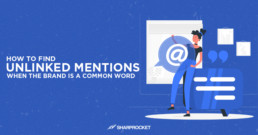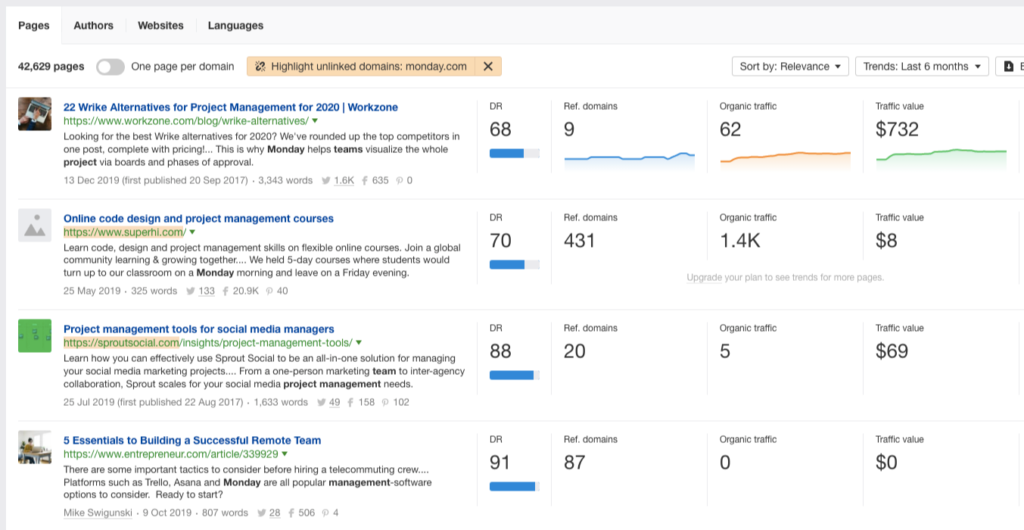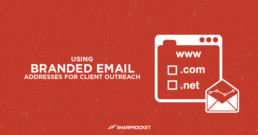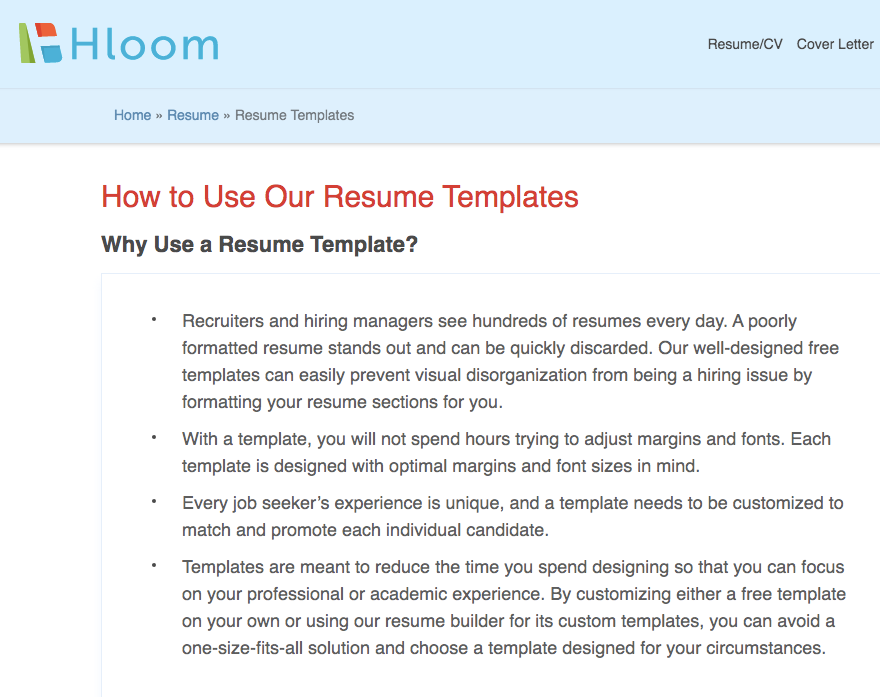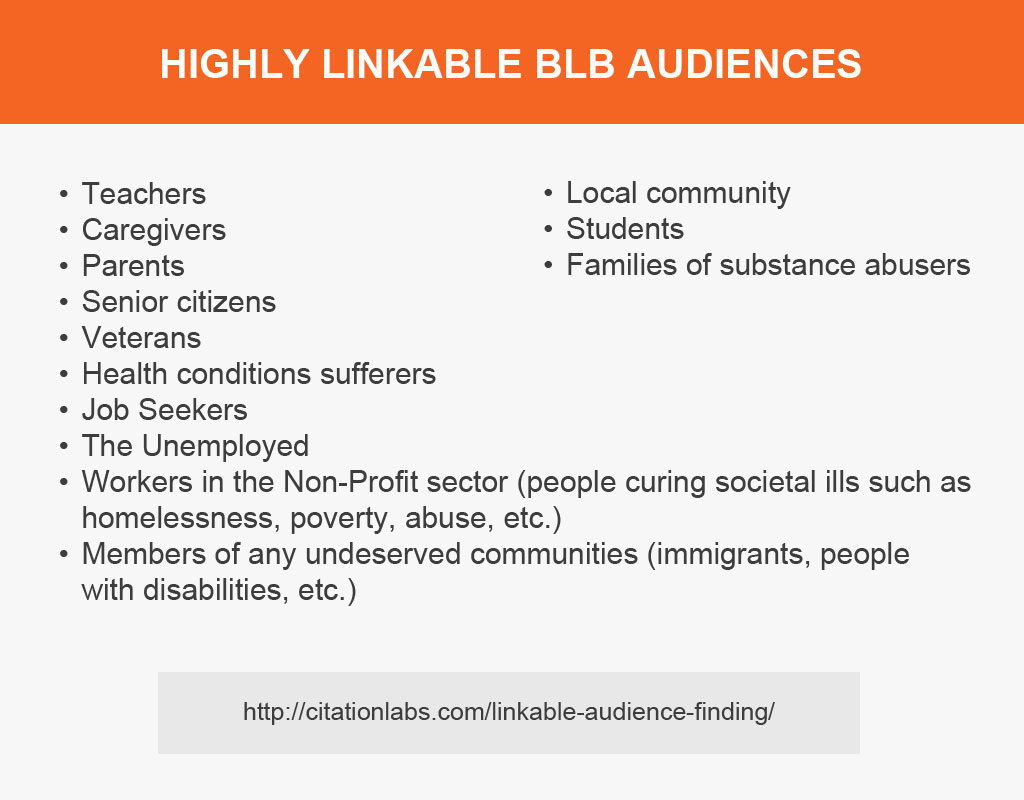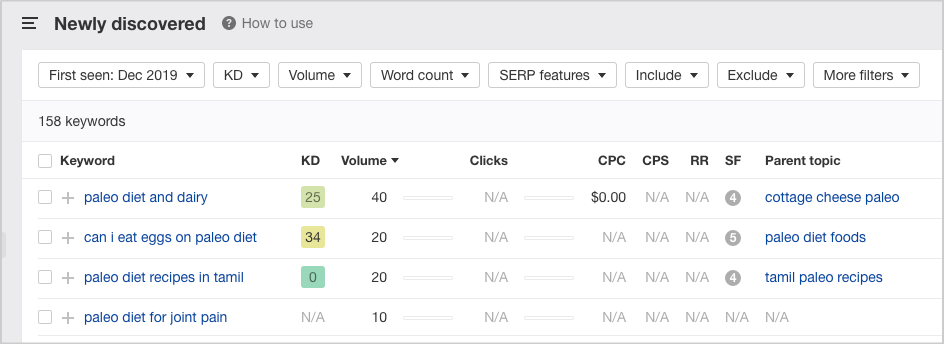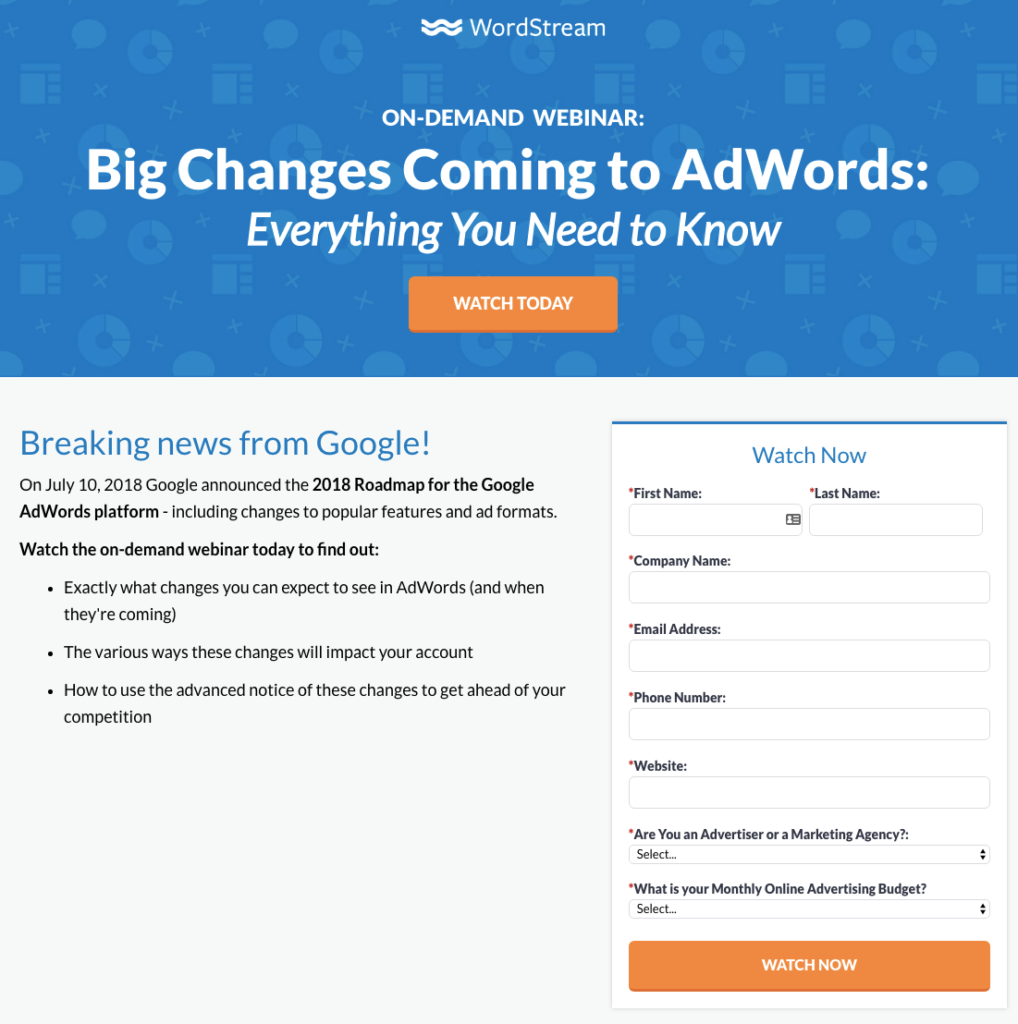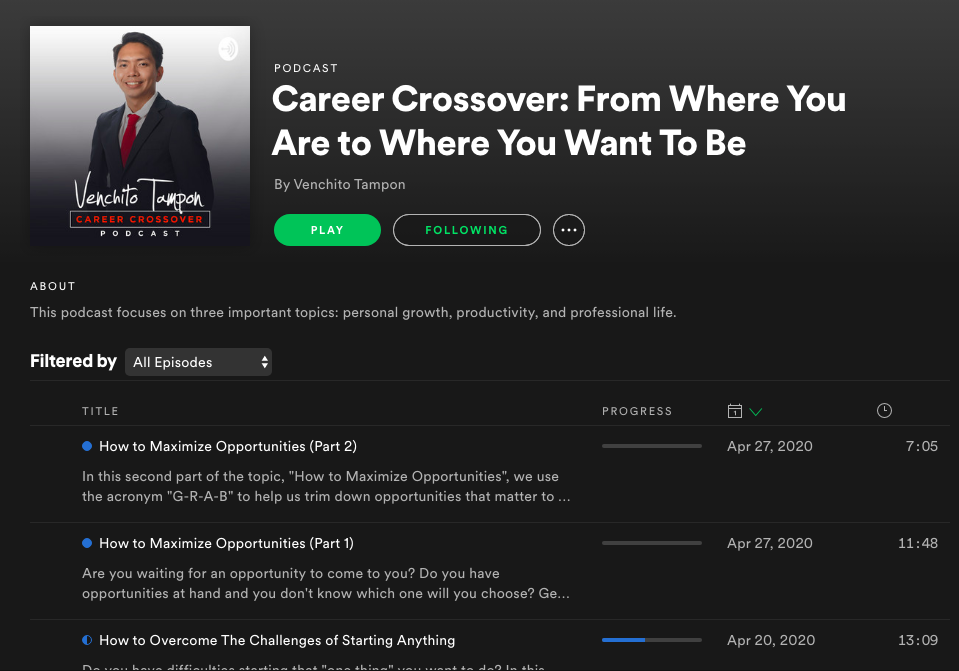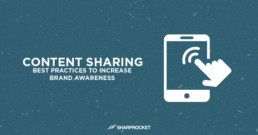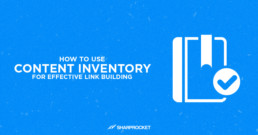How to Find Unlinked Mentions When the Brand is a Common Word
Link reclamation is a common link building technique for marketers today.
The idea is very simple: you get all those publishers or content creators who've mentioned your brand or your content but haven't linked to your site.
Then you reach out to them and ask to give you the links you deserve.
Oftentimes you gain a higher link placement rate than other link building techniques such as broken link building and guest blogging.
This is because there's already a brand connection between you and the publishers as well as an intended reason to link to you in the first place (they've used your content).
Here at SharpRocket, we've covered the entire process of this strategy in our link reclamation guide.
Like any other link building techniques, there are loopholes you have to consider by looking at methodologies that'll be effective to solve those particular problems.
In this post, we'll cover one common challenge link builders face when executing the link reclamation technique.
That challenge is finding unlinked mentions when the brand is a common word.
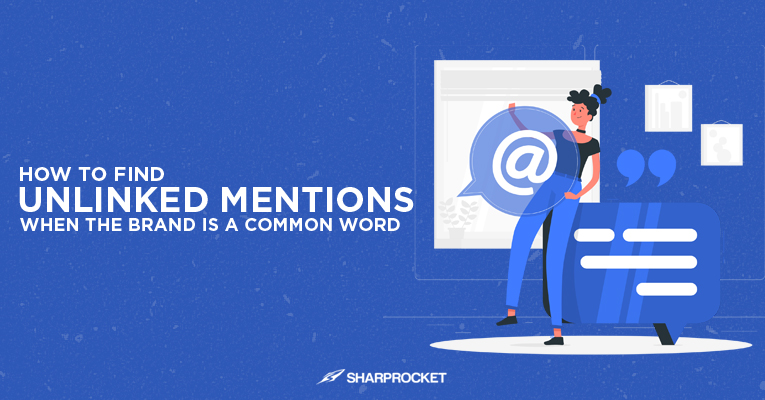
It's easy to spot pages that mentioned your brand if you have a unique brand name — i.e. Nike, Spotify, or Shopify.
There may be misspellings or typos as to how publishers may have mentioned your brand name on their posts — such in the case with Spotify or Shopify.
What is difficult to surface with are brand names with common words like Monday, or Apple. Monday is a project management software but is also referring to day itself. Apple as a technology company, while referring to a fruit.
As you go search for pages that mentioned your brand, you're likely to see different results. What do you do to sift through these results to only find relevant outreach prospects?
On Link Prospecting Phrases
Regardless of the tools, you'll be using for link reclamation prospecting, you need to have a list of words that should be associated with your brand.
In particular, these are your product types, product or service descriptions, or that one or two word detail about your brand.
Let's take Monday as our example. Monday is a project management tool. So, obvious words likely to be associated with are: 'Monday project management' or 'Monday task management'.
If you're working as an agency and this is your first client, you get to have a better understanding of your initial meetings with them. Having a good grasp of what they are and their products or services offer to the market would give you a list of words that define their brand as a whole.
You may opt into some research on Google by typing their brand.
For instance, a Google search result for Monday gives you the site's meta title and meta description. These are keywords the brand is trying to rank for in search.
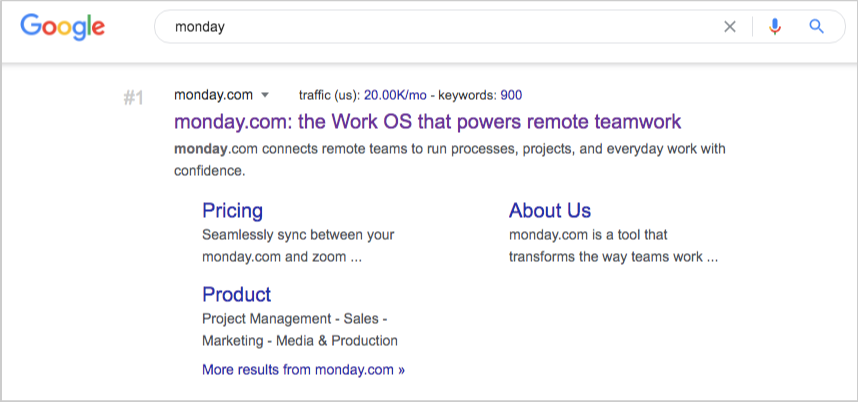
Add these words as your associated phrases to your link reclamation prospecting process:
- Monday remote
- Monday remote team
- Monday teamwork
- Monday remote teamwork
- Monday processes
- Monday enterprise
- Monday project
Another way to discover words you can add to your link reclamation prospecting list is by going through all of the existing mentions of your brand.
You can use Ahrefs Backlink Explorer to find pages already linked to your site. I prefer checking in pages where publishers usually linked to. These include your site's homepage and landing pages (e.g. product pages).
Sift through the pages and identify anchor texts publishers used to link to your webpages. There will be variations of anchor texts — long-tail description words and co-cited way of referring to your brand.
Add these newly discovered phrases (used as anchor texts) to your current link reclamation prospecting list.
Tools to Find Unlinked Mentions When the Brand is a Common Word
Link building requires some tools to surface brand mentions. Here are some tools you can use to find unlinked brand mentions.
1. Ahrefs Content Explorer
One of the tools that can help you with the link reclamation prospecting process is Ahrefs' CE.
There are a lot of advanced search operators in CE. If you're looking to return all pages that mention "Monday" AND either remote, team, process, project, management. You simply use "OR" to associated phrases.
So, the final advanced search query would be this: "Monday" AND ("project management" OR "remote team").

If your brand is a very common word, make sure you choose phrases rather than single words to return pages closest to what you are looking for.
Another strong tip is to exclude terms that refer to other topics not related to what your brand is about. For Apple, that might be "recipe", "pie", "cake", or "fruit" to exclude pages about the fruit term.
Be mindful that this may be tricky for some brands. In our example, "Monday" project management tool, if you exclude terms such as "day", "week", "month" or any calendar terms, you might end up excluding pages that mentioned both "day" and "project management" (which is about your brand) in the search results.
Hence, use exclusions if it makes sense to your brand.
Kindly click highlight unlinked domains and add the domain of your site. The websites of publishers that have never linked to you before will be highlighted, which means that the brand mentions those pages are unlinked.
2. Web mention tools
In link reclamation, you can't get away from using web mention tools. These are web products specifically designed to find pages of your unlinked mentions.
Examples of these are Ahrefs' Alerts feature, BrandMentions, and Google Alerts.
The same strategy with your search query inputs can be applied to web mention tools.
You can use any of the following search queries as your alert inputs.
Again, in our example today, you can have these queries:
- Monday remote work
- Monday remote team
- Monday teamwork
- Monday remote teamwork
- Monday processes
- Monday enterprise
- Monday project management tool
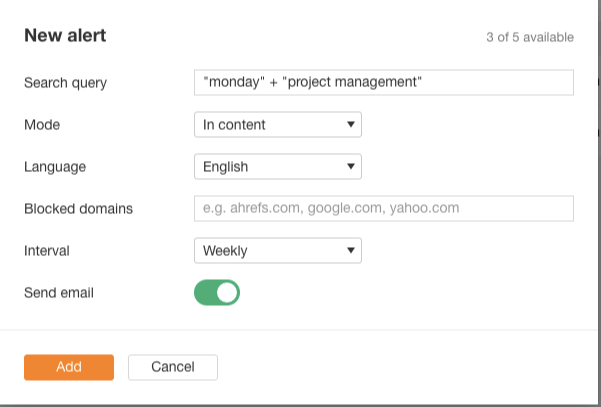
Exclusion and inclusion filters are also available in mention tools (AND, OR, —). Use them to your advantage to filter out irrelevant pages of your unlinked mentions.
Link Reclamation Made Simple
The most difficult challenge in link reclamation is sifted through results from your methods of link prospecting — manual and/or with the use of web mention tools.
If you're an agency, you get to master this strategy over time, as you can unpack ways to figure out how to discover unlinked mentions when your clients' brands are not common words.
Do you have any other tips to prospect for unlinked brand mentions? Let me know in the comment section below.
Outreach Strategies to Promote Infographics
When we think about outreach, we can't start without having a discussion about email templates.
Many content marketers, SEOs, and link builders will disagree with the use of email templates, as it would only appear not personalized to prospects they're reaching out to.
But the greatest link building minds actually use email templates to scale their link building outreach efforts.
In fact, without it, it wouldn't be possible to gain a consistent number of links for link building campaigns — whether that is for enterprise sites, niche blogs, or eCommerce sites.
Outreach templates are critically important to scale link building and to A/B test elements of email copies in order to increase positive results.
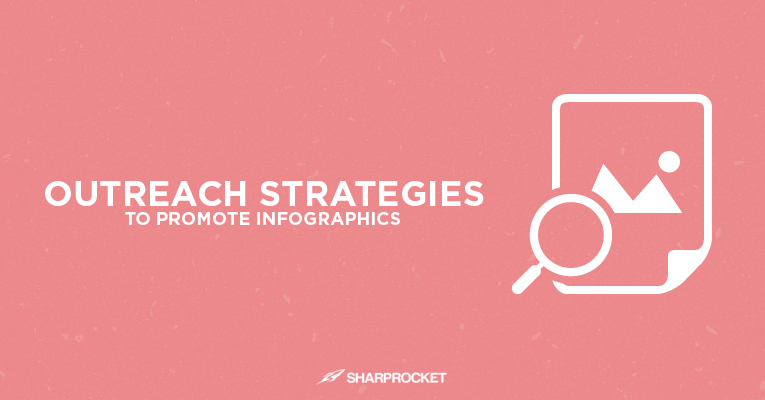
In this post, we're going to discuss a targeted outreach campaign — infographic outreach promotion.
What Makes Infographics Valuable For Prospects?
Value proposition is important to identify at the start of an outreach campaign. This will serve as the foundational message of an email outreach copy.
Infographics are highly valuable it if covers a message that no one else in the market has brought yet.
Of course, there is no such as this as an original content piece. Most infographics are derived from freely available data sources.
But If you can come up with an infographic that's worth seeing in terms of content format, information, and messaging, you'll have a unique value proposition your prospects would love to share and link to from their webpages.
Let's cover some best practices to promote infographics to build high quality backlinks and get the deserved attention from the audience.
A. Write custom intros for publishers
One effective content promotion technique for infographics is to offer custom intros to potential publishers. This exact strategy is part of guestographics — guest posts for infographics.
Its advantage is helping out these content creators struggling to write the text part of the content piece — an added value besides giving them the infographic.
When writing custom intros of infographics, it's critically important to write for the audience of the hosted domain. Know and understand their audience.
Your infographics may be the same piece published to all interested sites and blogs. But its well-written custom intros is what's make the visual content more significant.
B. Break infographic into individual images
Infographics are normally long-form type of content.
In fact, there's a myth that the longer the infographics are, the more valuable it is. But this isn't true all the time.
In many cases, infographics that are too long must be cut into several pieces to be able to fit websites and blogs. This gives followers of the website real estate to consume the content effectively.
You can chop your infographic into individual images for each section, point, or takeaway.
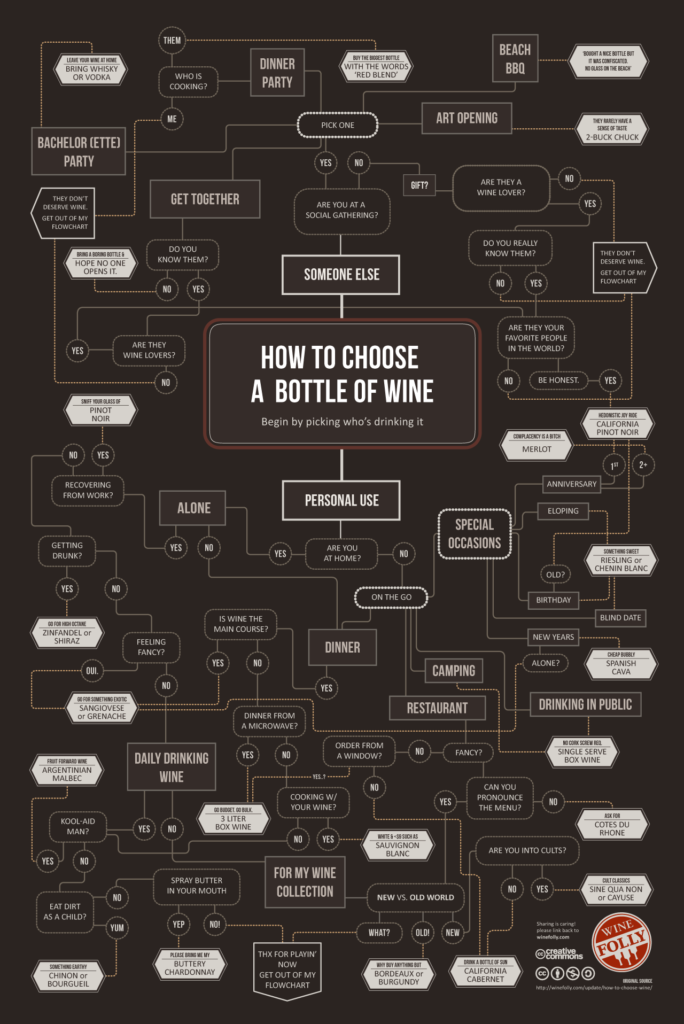
Instead of giving the entire infographic to your outreach prospect, you give them opportunities to use pieces of the visual. In that way, publishers can pick and choose images they think would be relevant for their future content works.
Once the infographic has been broken down into stand-alone images, you can create a gallery of these images — attaching it to your outreach emails like a little press pack.
Here are some examples of press packs from Distilled.
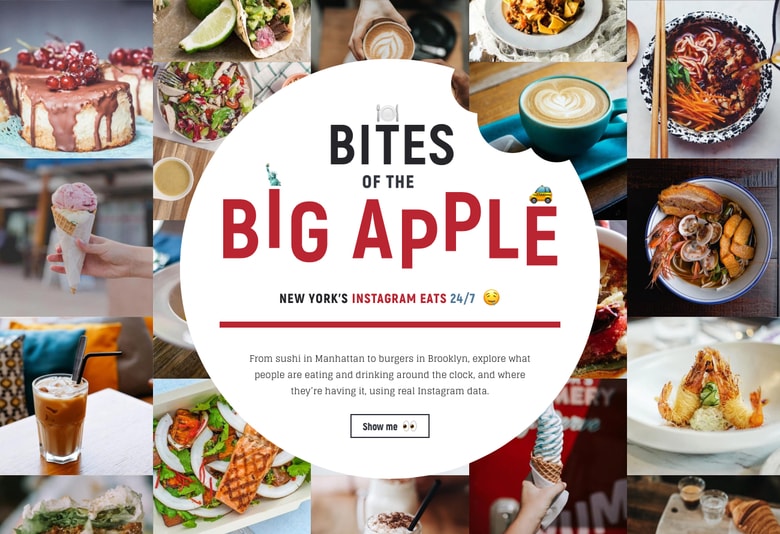

The same analogy of press packs can be applied to outreach in promoting infographics.
Whether you're reaching out to influencers or niche bloggers, you can attach a custom gallery of images as soon as they respond positively to your initial pitch.
Another method to present those images is to upload it on a third-party site and simply include a URL to your outreach email linking to the gallery of images.
C. Target different types of outreach prospects
Every content marketer promoting infographics wants to get the most number of links possible to its visual page — as to get more visibility and to distribute the messages effectively to its target audiences.
An effective outreach campaign starts actually with how well do you know your outreach prospects.
This involves targeting different types to expand your list and get the most out of the content promotion and link building.

Identify publishers who will be interested to publish your visual content. Start looking for some local angles of your infographic messages. It could also work well with the national press if you identify any fitting to your data.
Of course, you can't get away with your initial type of outreach prospects - niche bloggers and content publishers in your space.
Are there any news sites that can cover your visual content? Go and find any similar infographics and see who linked to their content piece. Often times, you'll find news sites you can reach out to for additional linking opportunities.
The idea of having different types of outreach prospects is to have your own split test. You can assess which types of sites respond better and double down your efforts for that particular segment group.
When you have many options for outreach prospects, you increase the likelihood of acquiring more links for your visual content piece.
You can use Ahrefs or Buzzsumo to find outreach prospects of site types I've mentioned earlier. And when finding email addresses, you can use VoliaNorbert to semi-automate the email finding process.
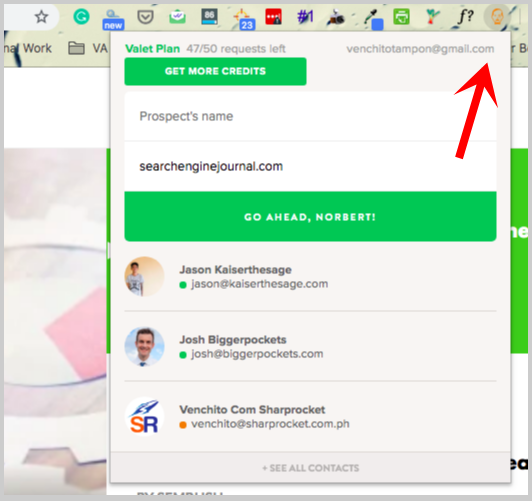
Organize your list of outreach prospects in a spreadsheet or in an outreach tool (Buzzstream, Pitchbox or NInjaOutreach)
Include necessary contact details and other pertinent information of link prospects that can help you personalize your email copies. This would make your outreach initiative much easier, as you have inputs in place for email templates.
Consider what type of email address you'll be using as a sender for your outreach emails. You can use your agency email address, or branded email addresses for your clients' outreach.
D. Use copywriting techniques for better engagement
Every outreach email has its own agenda — to get someone to take action. In this case, to publish the visual content piece your brand has created.
In making that happen, your outreach email must engage its target recipient from the start of the email down to your desired action.
This is where copywriting techniques come to play.
Gisele Navarro shared how to turn a boring email into an irresistible link pitch. In her post, she discussed this idea of using grease-slide copies.
You'll see most of these greasy slide statements in most of Brian Dean's articles at Backlinko. You may not be fully aware but you keep reading the entire post until its end.
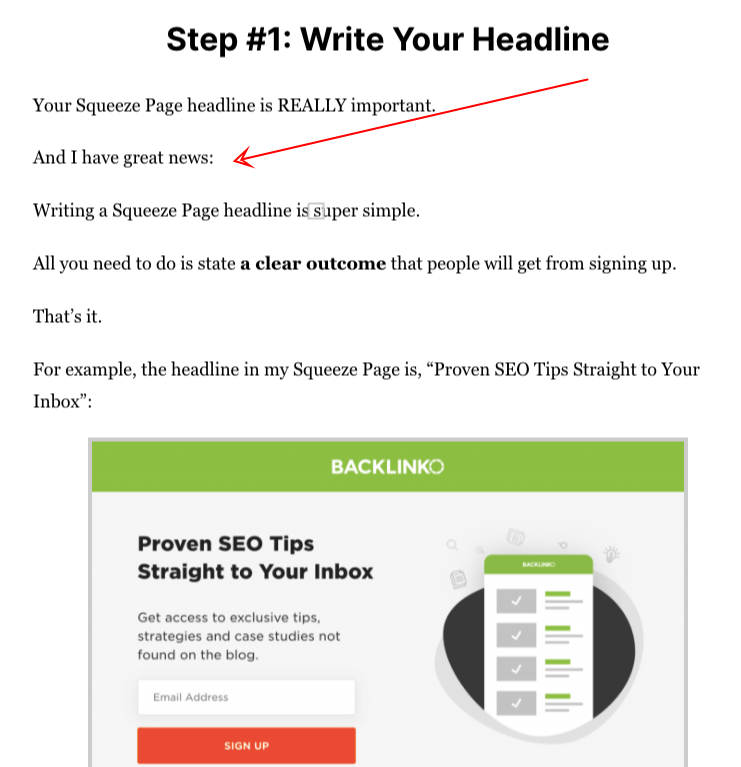
Grease-slide copy is a copywriting technique used to keep your readers glued to your page. So using phrases like:
- But wait — there's more.
- Yes, you read that right…
- We're not through yet.
Of course, not all of these grease-slide lines will work for your pitch. You have to check which ones are applicable to your outreach context. But if you can add these simple words to guest post pitch or any type of outreach campaigns, you can improve your outreach's response and conversion rates.
Make Your Infographic Outreach Pitches Irresistible
There are many outreach advice and email templates out there, but the one that would be effective to you is to write an outreach email from scratch based on your brand's messaging, context, and value proposition of your pitch.
Always improve your outreach copy based on the feedback of your prospects and the added value of your visual content piece. Make it irresistible.
Do Enterprise Sites Need to Build Links?
Enterprise link building is a different landscape. It requires a need for planning and knowing what expected results you want from a link acquisition campaign.
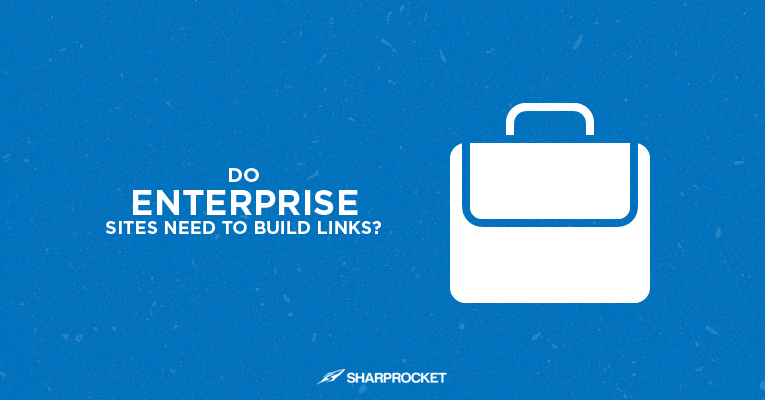
In today's post, we'll cover the need to build links for enterprise sites and understand what types of backlinks that will bring high brand value to them.
Do Enterprise Sites Need to Build Links?
The quick answer is yes.
Essentially, big enterprise sites are getting organic links, even without the manual link building campaigns.
Given their high-level top of the funnel and mid of the funnel content pieces, enterprise brands earn various types of links that bring more backlink growth than most small to medium business sites get.
However, most enterprise brands are not just waiting for links to come, but rather are more active in pursuing links. This is what we want to dig deeper a little bit — as to what types of links enterprises should be building for their sites.
Considerations When Building Links for Enterprise Sites
Since we are working with enterprise brands, we know what they're usually after in a link building campaign and what they do get out of it.
For many SEO and link building agencies, they know that once these enterprises' director of marketing or director of SEO reached out to them, these people know what to actually look for.
Though some may take some serious study and may need to be educated on why SEO matters to them, most enterprise clients who reached out have a good understanding of their needs.
Targeted Types of Pages
To be more effective in an enterprise link building campaign, one has to know the types of pages he/she should start prioritizing from the very start.
Generally, the focus of driving links are into core product pages — these are product pages that convert so well from sales and leads standpoint, but maybe struggling to get a ton of links.
To find viability for links, enterprise SEO teams will have supporting content guides internally linking to these product pages. These supporting pages will be used now as the value proposition to garner blog links or editorial links straight to them.
Another strategy is to add more informational elements (we call it as citable elements) to landing pages, such as product pages. By doing so, you get to serve a specific group of linkable audience and thus increase the likelihood of getting high authority links.
There is no successful link building campaign that will spend lots of money on random links. Enterprise sites have targeted pages they consider as part of their link building strategy.
Quality VS Quantity
Enterprise sites are aiming for both quantity and quality of links. They want to drive more, but highly relevant and authoritative links.
These authoritative links may have different benchmark metrics depending on which agency they're partnering with.
All backlink prospects should be relevant to the brand's content theme. It may be coming from industries, but sites that have engaged audiences enterprises cater to.
Besides relevance, metrics that I've found to get more buy-in from enterprise sites is the website's organic traffic, traffic cost, and brand value.
SEMRush helps you show websites' organic traffic and traffic cost. This gives you an idea if the website gets constant visibility from ranking pages on search — providing you with more referral visitors to your site.
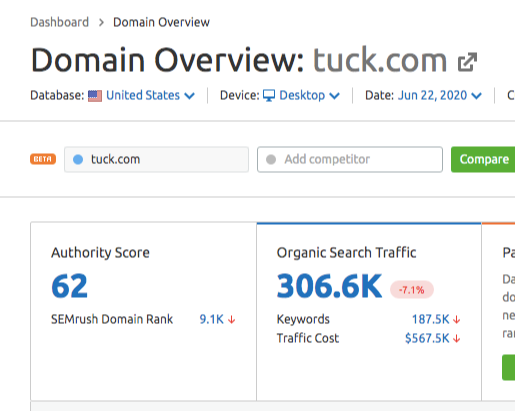
Brand value is also a key factor to consider in prospecting for relevant authoritative websites. This refers to how you see the potential linking site to give you better returns in branding impression as you go and get links from it.
Link Value Ratio
One of the big problems of many enterprise brands is not considering the link value ratio when executing a link acquisition campaign.
If you spend big budgets to build links to target pages that don't have any ranking and money potentials, you'll miss out on great opportunities that should've been invested in other content marketing initiatives.
Here is a great reference by Ross Hudgens that shows you how to compute for link value ratio.
Tactical Link Building for Enterprise Sites
A. Internal Linking
Oftentimes enterprise-level sites overlook their ability to leverage their internal linking capabilities. Their hundreds or thousands of pages can make wonders in terms of getting "quick wins" that they could have missed earlier if they proceeded right away to traditional link building.
Build internal links to funnel link equity to your most important pages. There are different ways to attack this one, and I recommend available resources below:
B. Link Reclamation
One of the best things to leverage in an enterprise site is its ability to capture the unlinked brand mentions from many sources.
A product worth mentioning on a blog post, a press release about your latest product feature, an interview about your executive about the changes happening in your company (or in your industry) are just some of the things you can monitor on a regular basis.
You can reach out to relevant publishers, content creators, or bloggers who mentioned any of your brand content (has your unlinked brand mentions) on their pages.
Get them to link to the most relevant page on your site.
If you're looking for a detailed process on this link building strategy, you can check out my guide on link reclamation.
C. Strategic Content Partnerships
As a link building company working with enterprise clients, what we've found to be a unique proposition for big brands is their pool of partners.
Those partners that they've built over the years can help set up collaborations much easier than usual.
Strengthen the brand more by associating it with well-liked entities. You can collaborate with other well-known content creators in producing a linkbait piece of content targeted to specific audiences.
Through content collaboration, you capture each of the content partner's followers and readers.
Another way to build high-value blog links is to create connections with authors who write for multiple websites about your industry.
These are authors who develop their personal brands to disseminate their messages in content by submitting guest posts to top-niche blogs.
So instead of the traditional guest blogging where you blast out distributed content to different blogs, you put your brand in a position where these guest authors come to you for links (link earning).
D. Reverse Outreach Campaigns
Reverse outreach is a strategy enterprise brands can take advantage of.
Instead of solely doing direct outreach to relevant publishers and content creators for external content distribution, they can leverage the power of linkbaiting — creating high-value pages to earn authority backlinks.
Since brands have strong domain power, they can rank pages for keywords in a short period of time.
One link building technique (earlier been mentioned) is the idea of inviting influential content creators to contribute and/or collaborate content for your blog.
The beauty of it is that you gain new expertly-crafted content pieces every now and then. You also acquire new links from these guest posts as they reference it (or externally link to it) from their other externally distributed content (guest posts).
Create more interesting content assets on your blog to attract links from relevant publishers as well as receive more targeted pitches from guest authors. Well then, you have your set of rules to select only practitioners who can write for your blog.
Having a reverse outreach strategy in place will keep you earning links consistently to your site.
Maximize Your Strengths As An Enterprise Site
There are many competitive advantages of running a link building campaign for an enterprise brand. With proper research and planning on highly performing linkable assets to inform future content creation decisions can help get low-hanging fruits of links.
Are you currently building links to enterprise site/s? Share any other link building tips in the comments below.
What To Consider When Using Branded Email Addresses For Client Outreach?
The difference between a great outreach campaign and a mediocre one boils to minor details outreach people don't want to discuss. This involves choosing the right email address to use for outreach.
One of the first things your target recipients will see from your pitch is your subject line and your email address.
Choosing an appropriate email address plays a big part in how your response rate and link placement rates will turn out.
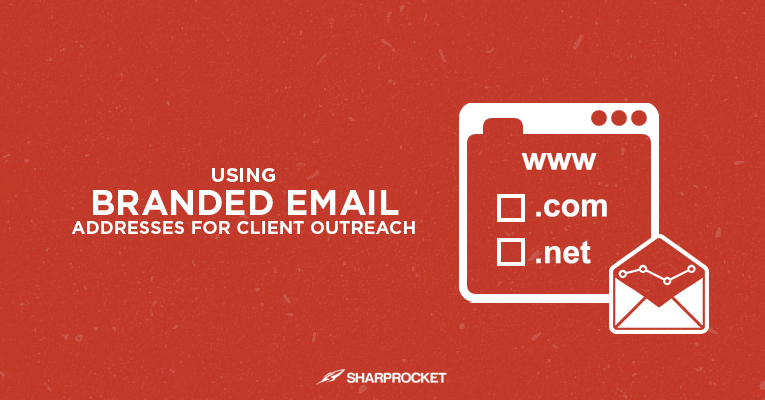
In this post, I'll dive into just one specific type of outreach email address — that is, branded email address and some alternatives if this type of email address is not available to use.
What To Consider When Using Branded Email Addresses For Client Outreach?
There are many variables when using branded email addresses that should be taken well into consideration.
1. Brand Recall
Brand recall means how strong your brand name is in your space. If a person mentions your brand, does it ring a bell to their ears?
Imagine receiving an email from AirBnb.

Would you hesitate to open the email? I guess not.
If people in your industry love your brand, using your branded email address should be of the highest consideration. It'll probably help to improve your open rates and/or responses.
In cases, you have clients with strong brand impressions online, use it as a leverage to penetrate link markets that may require authority or association of a strong brand.
There are editorial links from guest blogs and publishers that you can't simply replicate without a proper outreach plan. An outreach campaign with the use of a corporate email address of the client helps build initial trust — others won't.
2. Existing Relationships
Another consideration for branded email addresses is the advantage of building stronger relationships with niche publishers, journalists, and other content creators.
For long-term viability, if you use a branded email address, you incorporate all email connections in just one client.
Imagine if you have 5 email addresses that you use for one specific outreach campaign, that may be good for A/B testing, but you know that it will be a hassle to see emails and reply to individual messages.
Recently, I got a pitch from Sujan Patel, a SaaS marketer, and founder of MailShake and Ramp Ventures.

He and his team wrote a guest post on how your content strategy can support your sales team.
Before the actual content being written, it's interesting that what made me open the outreach pitch is the brand recall of Sujan Patel. He is widely known in the digital marketing realm, giving mentorship to some of the best SEOs like Ross Hudgens.
In addition, the relationship I've built with Sujan Patel from the back and forth email conversations and sharing each other's blog posts makes it easy for me not to think twice about opening his emails.
Using a branded email address has the advantage of increasing open and response emails from the initial outreach even up to sending them follow-up emails.
Your client's brand has connections with business partners and online publishers that have to be maximized fullest in terms of content promotion and link building.
3. Coordination with Legal and PR Teams
Large enterprise teams have their legal and PR teams in place.

One consideration when choosing a branded email address is your outreach team's awareness and coordination with legal and PR teams.
There have been many backfires to digital and SEO agencies because they weren't aware of certain protocols following usage rights — including the use of corporate email addresses.
Make your PR teams aware of your outreach process end-to-end. So if things go awry, you won't be in a total mess.
Alternatives To Branded Email Addresses (When It Is Not Available)
There are times when branded email addresses are not available to use. Either the client is strict in not giving away branded email addresses for corporate reasons or there's no chance to get in touch with the IT department to get at least one corporate email address.
In that case, what do you do as an outreach person?
In case a client doesn’t want to provide branded email addresses, you may opt to either your agency's email address or to an outreach email persona.
There are, of course, advantages and disadvantages of using either an agency email address or outreach persona.
For the agency's email address, one of the pros is the connections that have been attached to the account for months and years of doing outreach. By having that as an arsenal for outreach, it can give your outreach team an edge over other people pitching the same link prospects.
There is also a disadvantage for SEO agencies using their corporate email address, particularly to brands with "SEO" and "links" attached to brand names.
There are publishers and bloggers who itch when they see the words, "SEO" and "links", it's as if they are thinking they've been pitched for the sole purpose of links — without providing any value to them.
These are things you've got to keep in mind when choosing alternatives to branded email addresses.
Further Reading Resources:
- How to Find Any Email Address: Seeking Email Superheroes
- Six Small Differences You Can Make to Your Email Outreach
- How to Send a Follow-Up Email After No Response
- How to Use VoilaNorbert For Linker Outreach
Consider Details of Effectiveness in Outreach
While there are many facets to consider in an outreach campaign, you go over and consider even the tiny details of outreach.
As I've discussed, not knowing the repercussions of choosing a branded email address may give you a blow in your future outreach results. So better start thinking of plans to make it work best for you.
Are you considering using branded email addresses for your client's outreach campaigns? Share any other tips or considerations in the comments below:
How to Create Link Assets in Boring Niches
The reality is not all industries are fun to create content with.
There are what we call "boring industries" that you won't take much pride in content creation and promotion.
But that's just because you find it boring doesn't mean there's no way to pursue linkable asset creation.

In this post, we'll discuss three ways to create link assets in boring industries.
1. Generate Safety-Focused Content Ideas
Topics on safety have never been more linkable than ever before. Particularly, in this Covid-19 season when people are experiencing tough times, producing content for safety can help your site earn natural links.
Start generating safety resources, including MSDS.
Material safety data sheets (MSDS) are documents that contain information on the potential hazards (health, fire, reactivity, and environmental) and how to work safely with the chemical product.
These may be a little bit industrial or too technical as you think, but safety-focused content just like this can generate tons of links.
Another way is to tap the safety needs of your target audience.
Safety needs, this pertains to four types:
- Financial
- Emotional
- Physical
- Social
Depending on your industry, you can think of ways on how to create content that gives information on any of the four safety needs.
By simply using common sense, you can think of ways on how to generate content ideas quickly.
Lift Maintenance Example
For example, if you're working on a "lift maintenance" — social safety is of top priority.
A content that answers "what to do you do if you go to get in an elevator but see someone else is already in it?.
An even shorter version of link asset would be this: "Social Distancing Inside an Elevator".
Insurance Example
Another example is the insurance space.
Any information to help a specific group of people stays financially safe during economic hardships is a great content idea.
Start thinking of ways on how to teach people with saving, making, and spending money. By looking at financial safety as your main agenda for link assets, you can quickly generate ideas for yourself.
Learn from highly linkable assets in boring industries.
You don't have to reinvent the wheel all the time. Find content pieces that have gained massive links in the past — to give you some inspiration as to what format of content works.
Here is a good example of an interactive guide on home protection. It deserves the title, "ultimate guide", as the link asset covers information in a very visually appealing manner.
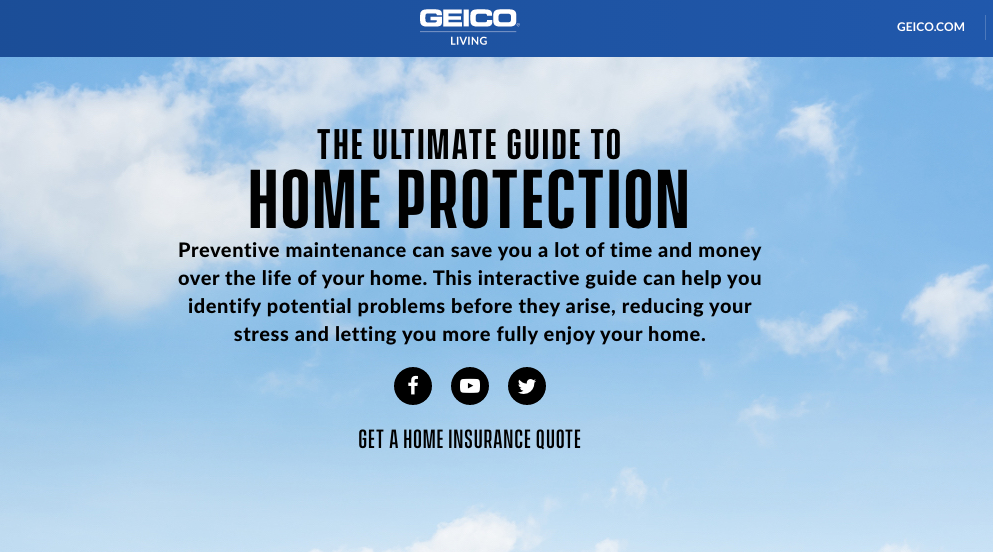
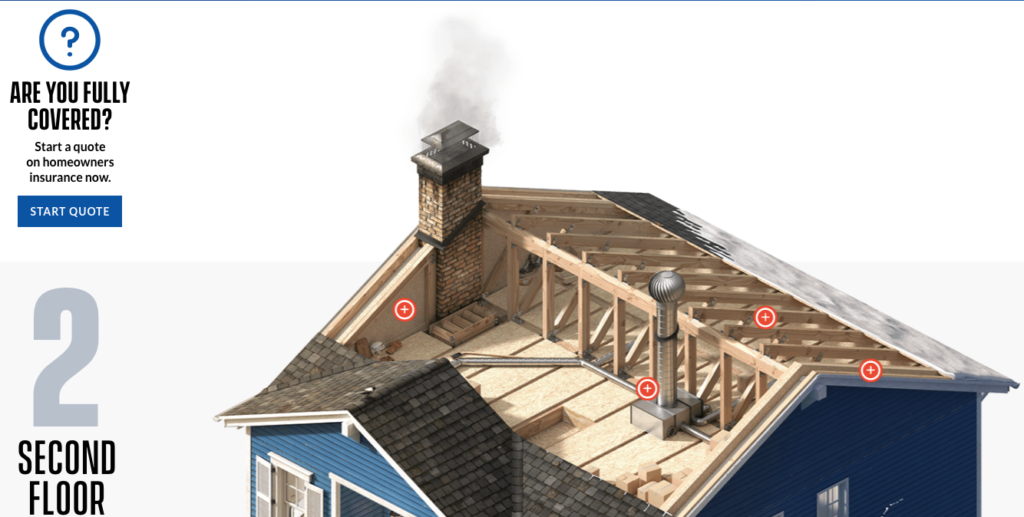
By looking at what other successful content creators in their respective industries, you can replicate some formats and methods of creating content and apply it contextually to your own brand.
2. Appeal to Educators
The best way to build edu backlinks is to appeal your content to educators.
Educators are looking for link assets for targeted audiences, including:
- Comprehensive cheatsheets
- Job-seeking guides for students soon to be working in your niche
- Faculty member discounts and deals
- Research-driven piece featuring educators and practitioners
By building link assets targeted to students, faculties, and expert practitioners in the academe, you'll get chances of creating backlinks from high trusted websites — particularly, from .edu websites.
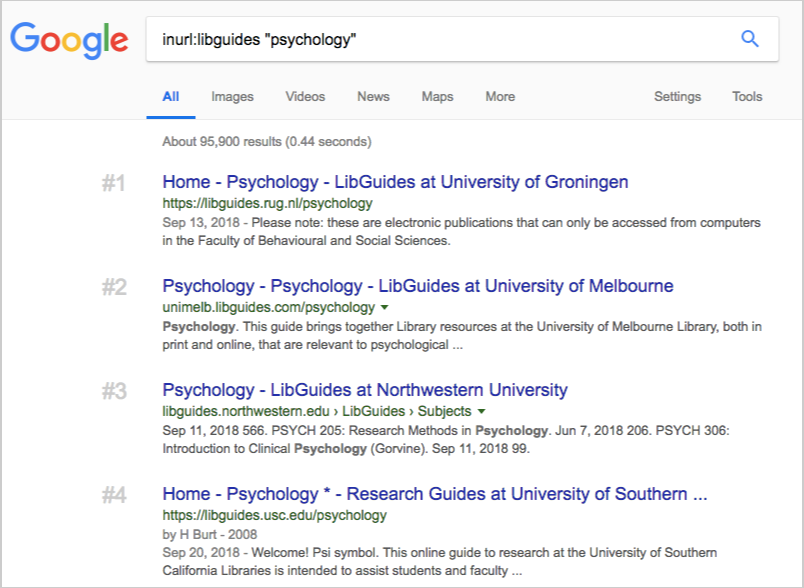
You can proceed to find resource pages that fit your link assets. Reach out to them and share them with your content piece. There are many library guides on different subjects that will be niche-relevant to your space.
You can check out these guides on broken link building and resource page link building to learn more on how to leverage links from resource pages.
You can also collaborate with current contributors to edu blog sections. These are regular writers for the edu blogs that are giving out information for their readers.
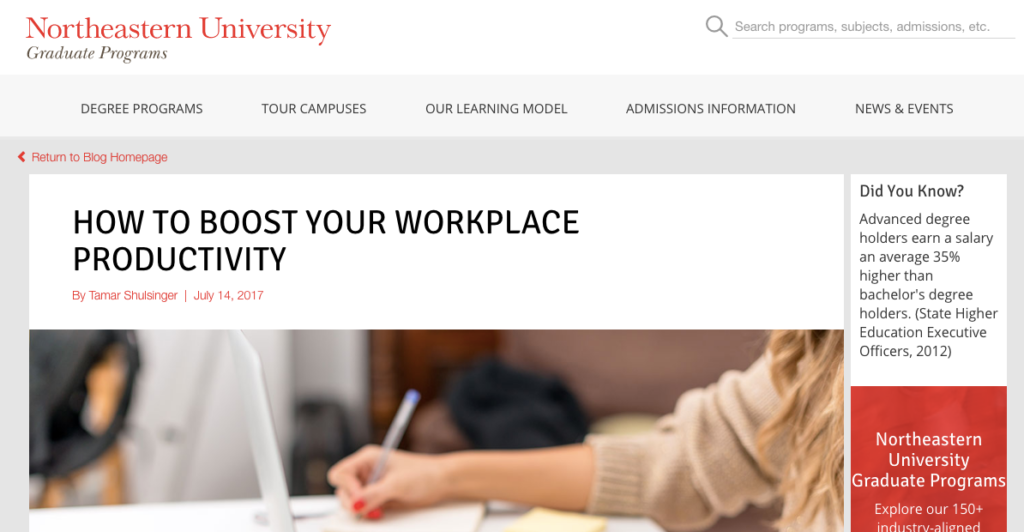
By learning about their writings, you can identify if they're externally linking to references outside their own webpages. This way, you know if you have chances of getting editorial links from their future content.
Start reaching out to them and share the link of your link asset.
For example, this energy plan comparison website produced an animated guide to the science of wind turbines.
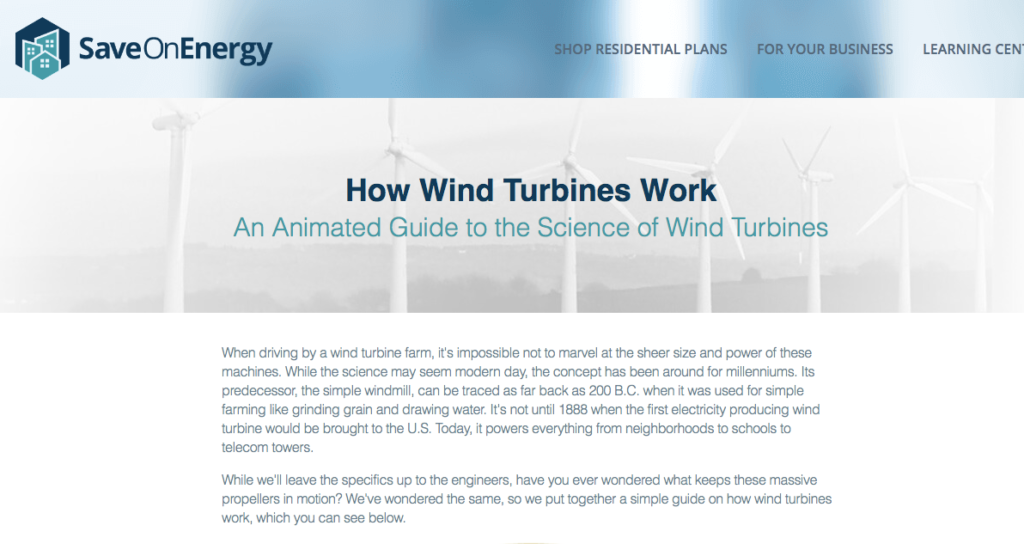
Because of its design and well-meaning technical information, it got links from edu blogs — increasing the visibility of the content to its intended readers.
3. Develop Newsworthy Data-Driven Content
If you think your industry is boring, why not check out some data available online and see how you can turn them into amazing content pieces?
Here is a list of data sources you look upon some information relevant to your brand.
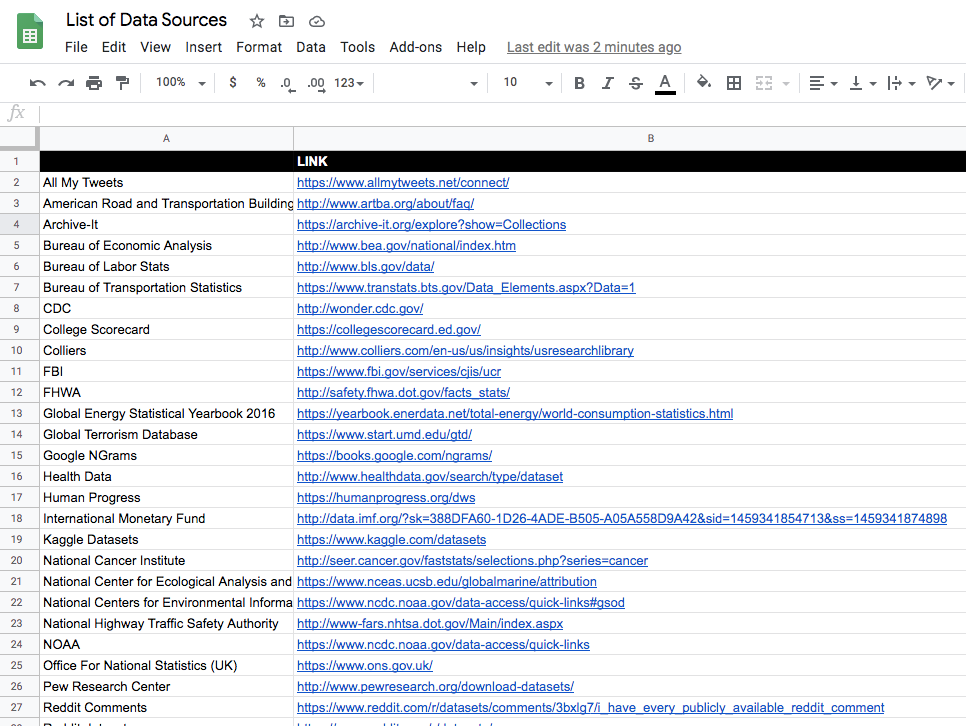
You can also learn from how other data-driven content has been putting information out there and to make your link building campaigns more effective.

Going back to our previous example of a lift maintenance company, you can apply the same concept.
You can research on interesting lifting things and compare them in apples to apples way. Design the piece with styles to make it more attractive to content consumers.
Always make sure you do some research first for any data you'll be putting out on your blog. That may be apparent, but I find content creators lacking the diligence to sift through information — leading to mediocre content work.
Your Niche May Be Boring But Don't Be a Boring Content Creator
Pursue excellent content creation despite the lack of energy and creativity to find "fun" in creating link assets.
What I've shown you earlier may give you insights into what type of content will best work for your industry. Be more diligent in tapping existing linkable markets. It's one of the best ways to start your link campaign for a boring industry.
Start with that. Learn from other brands that have successfully produced high performing link assets.
5 Ways to Build Links to SaaS Template Pages
If you are working on a SaaS (Software as a Service) website, then there are certain pages you want to target for links.
Either the page hits your bottom of the funnel (generate direct sales or leads), or it's part of your top of the funnel pages — to gain the interests and attention of your target audience without directly selling to them right away.
One type of page of SaaS sites that SEOs and link builders are having difficulty getting attention in terms of links are "template pages".

Insights On SaaS Template Pages
With template pages, it can be as helpful for your target audience — as it teaches people how this little tool solves a particular need (e.g. invoice templates for small business owners).
Your SaaS template page can also directly tied to your products, giving people a step by step guide on how to use the template along with the software your brand offers.
The second type of template is the most challenging. You often SaaS template pages attached to products - which makes it salesy.
If you've been building links for a while, you know sales pages don't get many links, as linkers find it uninformative for their target audiences.
In this post, we'll cover 5 ways to get backlinks to template pages of SaaS websites.
1. Learn from template-specific sites
It's no wonder to find it difficult building links to SaaS template pages.
But one of the key methods to discover if there are link opportunities for that specific type of page is to go look for template niche websites.
These are websites with template only content.
Take a look at this example:
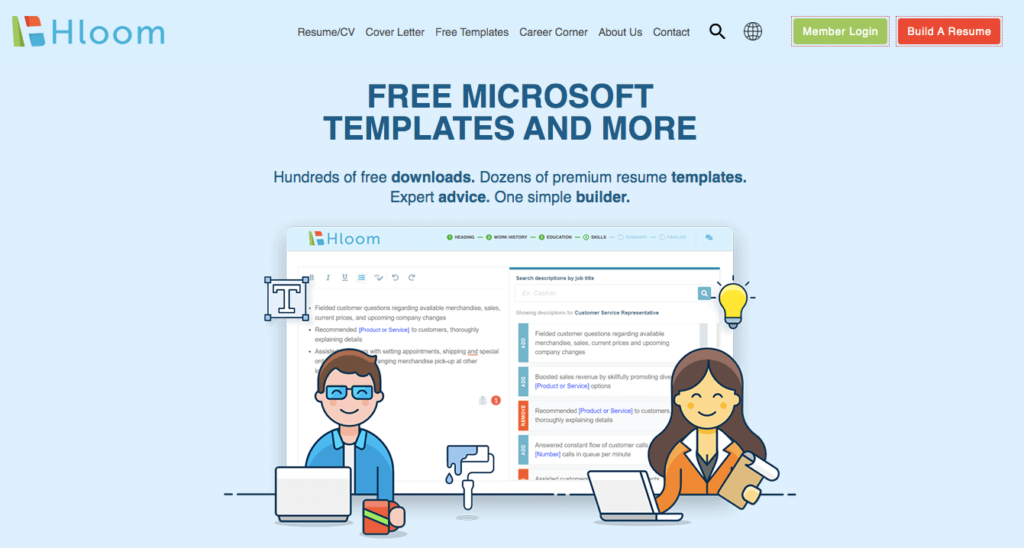
Hloom provides hundreds of Microsoft templates on the subject of career. They've been pushing high-value linkable templates that no one else in the market can publish.
What makes Hloom's templates linkable?
Their template pages are tied into other linkable content pieces.
The 100+ template content asset may not be highly linkable at the start, but accompanying it with other related linkable assets makes it easy for content consumers to see the template piece.
You can apply the same strategy to your SaaS template pages. Can you internally link to the page from other related more linkable content assets?
Sidenote: 5 Linkable Assets Examples (How to Create and How to Build Links to Them)
In our Hloom's example, resume templates page is tied to other related pages like, "How to Write a Resume", or "Resume Formats".
By adding internal links to your template page from other more visible pages, you're likely to get more eyeballs and potentially attract links to your main piece — your template SaaS page.
Another way to make your template asset increase its linkability is to add FAQ (Frequently Asked Questions) and even a section that shows how to use templates. In Hloom's case, there's a section on "How to Use Our Resume Templates".
2. Add citable elements to your SaaS template page
The hardest part of link building for SaaS websites is justifying the "citability" of your page. If it's too salesy, you're less likely to get links.
But that's not the case if you add citable elements.
What are these citable elements?
These citable elements are more informational and educational for a targeted audience. It's different from pure sales content, as it is more referential in its nature.
Here are some citable elements you can add to your SaaS template page (as mentioned by Garrett French):
- Data or “findings.”
- Direct quotation of a source.
- Defining jargon and industry terminology for the layperson (aka definitions).
- Pricing Guides or Generalized Pricing Information.
- Images, Videos, Widgets, Downloadables.
- Detailed, Multi-Faceted Metrics-Based Reviews.
- Tips/Advice Directly Related to Products/Services on the Page.
- The Origin Story.
- Supplemental Outbound Resource Links.
Apply it to the context of your industry and to what your target audience is looking at in terms of links.
You may find that by simply adding a "data" or "findings" will work wonders in gaining links to that page.
Double down on those efforts if it brings you maximum impact on links.
You can check out my guide on creating resource pages if you want to know more about linkable audiences.
3. Leverage resource page opportunities
When there's a justifiable reason for citing your SaaS template page, there is likely a certain type of link opportunity.
For template pages, the most common type of linkers is resource curators.
In our Hloom example earlier, you'll see bunches of resource curators - seniors, students, parents of teenagers, and people with disabilities looking for job opportunities.
Fortunately, the template piece serves many resource curators audiences. That may not be the case for your SaaS website, what you can do then is to tie it to or add a citable section to your template page that may well serve any of the linkable markets below:
4. Build landing page links with brand mention outreach
Depending on how huge your SaaS website is, you'll manage to find a lot of unlinked mentions of your brand, most of which will come from pages citing or referencing your tech products.
Most of those brand mentions are primarily for your homepage.
That's okay. But you want to get more specific links — more relevant links, if you may.
You can ask publishers who've mentioned to direct to your SaaS template page — you may see at times that these publishers are receptive to your link requests.
Instead of them giving links to your SaaS homepage, they could link to a more relevant page — SaaS template or your product page.
There are many tools to help you out with the brand mention tracking process — one, in particular, is BrandMentions by Razvan Gavrilas.
Here are more resources on brand mention tracking:
5. Tap off-site brand content like blogs
Take the "restaurant website template" as an example.
It's not a solid linkable piece if you ask me. But there are ways you can go address the needs of business owners, which makes the content more compelling for linkers.
You can search for blogs and look at any topics that might seem more relevant for entrepreneurs. Topics like smb management, digital marketing, or customer relationship management.
You can apply the same method to your brand context.
Check any bloggers and other publishers in your industry that post about "things to consider" or "how-to" articles where the topic of your SaaS template page may contextually fit, at its best.
By doing some research on maximizing "offsite brand content strategy", you'll find ways to penetrate bloggers in your space.
Make Your SaaS Template Pages Link-Worthy
If you're a SaaS founder, marketer, or SEO, you know this part is difficult to execute. But there are methodologies and actionable tips you may find useful in this post. Apply it to your own context and let us know in the comment section below your experiences, so far.
7 Ways to Discover Unique Blog Ideas
Choosing blog topics is a difficult task for most content creators.
It entails several challenges including:
- knowing if your blog idea will resonate your audience
- checking if your content idea fits your brand's content theme
- identifying the uniqueness of your blog topic
The last challenge may hit you big.

In today's environment where most entities and personalities are dishing out more content than the normal frequency, it's important to understand how to be different, and not just be better.
Be Different in Content Topics
There are companies and individuals who are better than you in producing content. They may have bigger budgets in content production, and at most, are very creative in their content assets.
What do you do if that's the case?
You think of ways on how to make your content different. It starts by discovering unique blog ideas.
These unique blog ideas are not 100% original. That will be apparent. But the seven tips I'll be sharing with you will help you generate unique blog ideas for your website.
7 Ways to Discover Unique Blog Ideas
Here are seven unconventional ways to come up with blog topics that will resonate with your audience.
1. Generate topics from bigger content assets
Brands with consistent blog post-production have bigger content assets than what the most usual niche bloggers publish on their sites.
This is where you can take advantage of their long-form content pieces.
For instance, if you see chapter guides, you take a look at each chapter and see if you can expound and/or elaborate it on your blog.
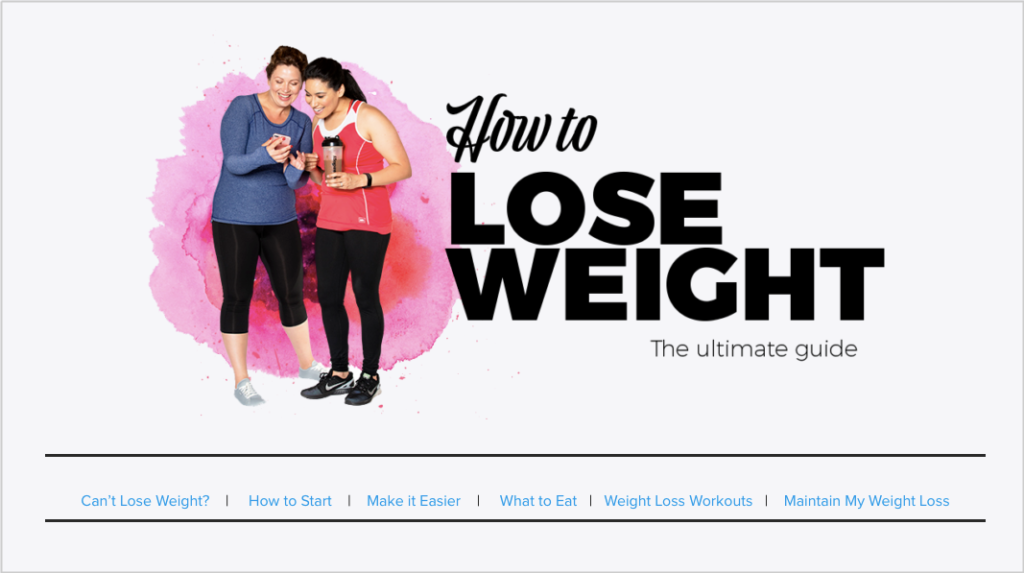
In each chapter page, there are more topics you can expound further depending on how specific it is and how it is possible to get it discussed on a separate page.
Besides chapter guides, you can also check ebooks of brands you're in with the similar content themes.
Go look at each chapter and specific points included. Check if a topic you've seen can be an idea for your blog content.
2. Discern emerging topics
In any industry, there are many topics that arise from the increasing demands of consumer needs and the positive effects of technology.
This gives new topics to consider for blogging.
For this process, you can use Exploding Topics. It is a website co-created by Brian Dean of Backlinko to help you discover growing content topics before they take off.
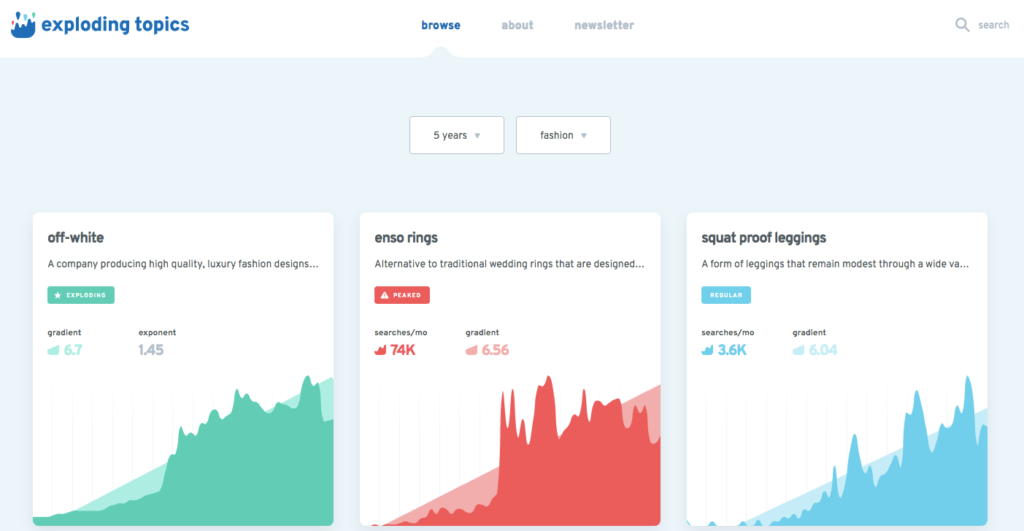
By tapping into emerging topics, you are able to create blog posts that your competitors may not have even think of. This kind of initiative gives you an edge from a content marketing perspective, as you can differentiate from many other similar content creators.
Another tool you can use is Ahrefs. Use it to find new keywords relevant to your blog.
3. Use 'Socratic Questioning"
To be different, you need to ask deeper questions for your content.
Why is it so?
By asking questions, you get the right answers which may lead to better insights about the topic.
One of the ways to leverage this technique is Socratic Questioning. Using this method, you can unearth points and niche topics that will be helpful to your audience in understanding concepts and frameworks on a deeper level.

The Socratic way of questioning has some objectives to help you derive great answers. These include:
- Explore complex ideas and to get to the truth of things
- Open up issues and problems
- Uncover assumptions
- Analyze concepts
- Distinguish what we know from what we don't know
- Follow our logical implications of thought or to control the discussion
The way you can apply Socratic questioning is to get all your possible topics and to scrutinize them using the objectives above. By doing so, you uncover some more points which can serve as individual topics for your blog.
4. Get into the mind of your audience
Know your audience's needs. This may come in the form of finding their frequently-asked questions.
The go-to site for questions is Quora. You've heard it before. In fact, I've written a whole guide on how to use Quora marketing for businesses. You might want to check that out.
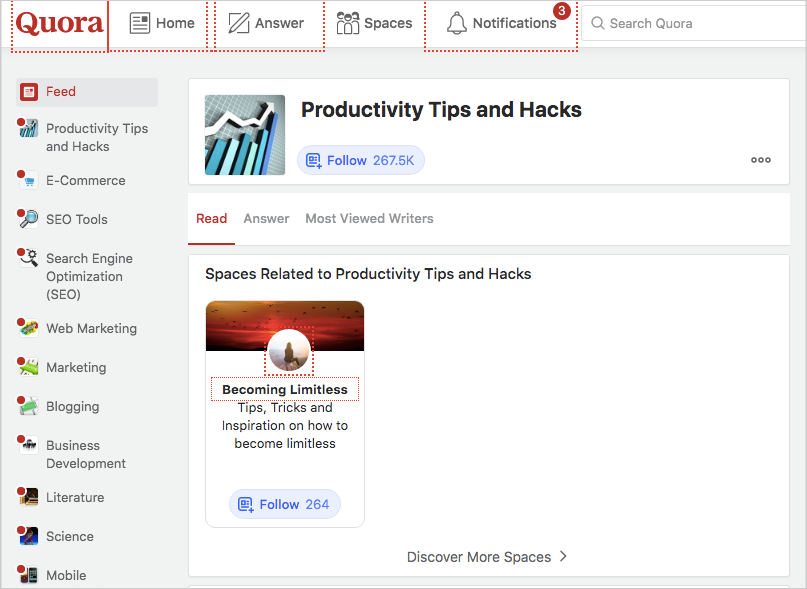
Another platform where you can discover people's questions is Answer the Public. By searching for your keyphrase, you'll find a wide array of questions you could consider as unique blog ideas.
Ahrefs also has a feature for 'Questions' keywords. Utilize it to discover more industry-related topics for your blog.
Lastly, you wouldn't want to miss out on participating in niche subreddits. There are industries where Reddit users ask the toughest questions to the community. Take advantage of it as it could open up new insights for your blog post ideation.
5. Learn from your content competitors (don't just mimic)
Competitor research is a critical aspect of content marketing. With this initiative, you'll find ways on how you attack your content in such a way that differentiates your brand from its blog contemporaries.
Don't just mimic what your competitors are doing with their blog content. Make sure you learn from how they produce their content pieces.
One way to do that is to identify their pages that sending constant traffic to your prospects or competitors. These are basically top links from other sites linking to your competitors' content.
In this case, we use Ahrefs' Referring Domains feature to find out those linking pages.
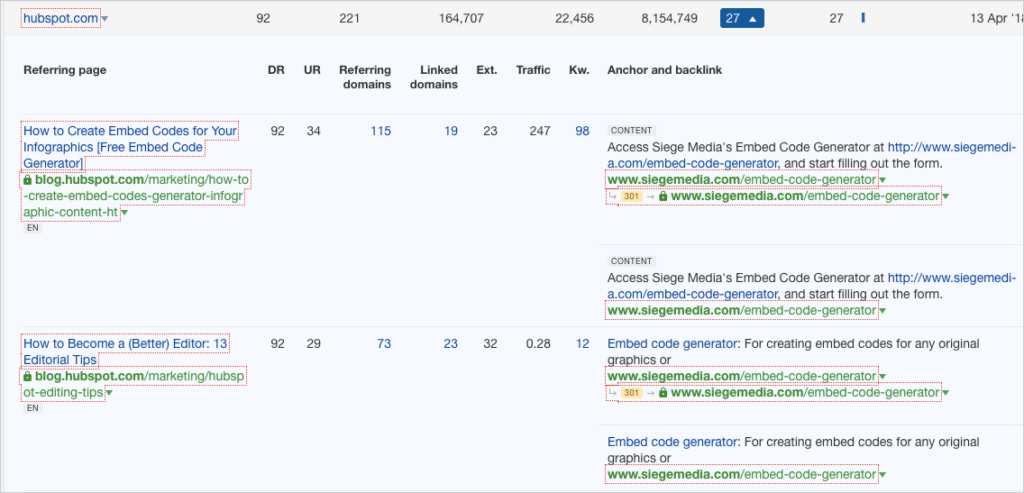
What you are looking at here are blog topics that have demand attention from people in your space. These are within areas in your industry that your target audience would likely engage in.
Check those linked-to pages and see how you can create a better version of those pieces. You may also find it to use "created a better piece on… " as a value proposition when pitching potential prospects for links (when you reached out to linkers to your competitors' most-referred-to content - examples is blogger outreach).
6. Take notice of where you are exposed
Your brand has been exposed for years that get you earned mentions from relevant publishers and news websites.
Take advantage of brand mentions as you'll be able to generate more unique blog ideas through those.
By looking at the topics of content where publishers mentioned your brand elements or your content piece, you can see ideas that get attention from content consumers in your industry.
There are web-based tools to help you with tracking mentions and alerts about your brand or your content asset (whether that's an infographic, video, or article).
Two recommended tools are BrandMentions and Google Alerts. Start tracking places where you have been exposed and get unique blog post ideas from that.
7. Leverage content gap analysis
Content gap analysis helps you accomplish the objective of putting out content that your competitors have already discussed.
While that may sound mimicking only your competitors, you only use that as your headstart. Along the process, you find points of differentiation when you looked at your competitors' similar content.
I've covered this entirely on my guide on content gap analysis - you may want to check this out as your reference.
Further Resources:
- How to Start a Blog - Beginner's Guide to Blogging
- How to Use Blogging For Personal Branding
- How to Build Relevant and Authority Blog Links
Key Takeaways
Identifying and pursuing blog post ideas that are unique can help your brand elevate its differentiation in your space. With tools and proper planning and research, you'll be able to produce content pieces that get more eyeballs than the usual attention.
Apply the seven tips to generate blog ideas to your own context. Know what works.
How to Use Webinars For Link Building and Lead Generation
Webinars are all over the place. From left to right, we see entities, businesses, and individuals using webinars to promote their own messages to people — whether for the purpose of educating their audience or selling them products or services.
What makes webinars so useful is its built-in value where knowledgeable experts share their insights on a given topic. The value of content increases even more as the expertise to skills becomes more relevant and more useful to the audience.
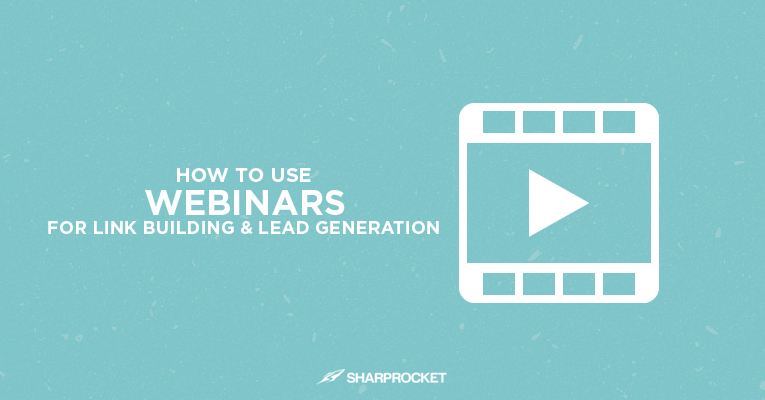
There are different formats of webinars, most of which come with a full seminar-like discussion on a subject matter. Others prefer to have an interview or Q&A type discussion with esteemed guests.
This now gives us a full reason to maximize webinars for the purpose we're engaged in.
In this post, we'll cover how you can use webinars for link building and lead generation.
How to Use Webinars For Link Building
Content is king - no doubt. If you don't have content to offer to potential linkers, you're less likely to get links. Even if you have established thought leadership and authority in your space, you still need to produce content pieces to attract high-quality backlinks.
Webinars help you pursue link building. You only need to be strategic in how you develop this content piece and distribute it massively to your target audience.
Guest on topical webinar series
First in the list of link building techniques is reaching out to content developers with webinar series. These webinar series feature guests in the industry who can be part of the discussion — either as a webinar lecturer or guest interviewee.
Take advantage of this opportunity given that you can hit two birds with one stone — get links from webinar transcripts (once the content is published on the creator's blog) and increase brand awareness for your site.
Take a look at this webinar series by Search Engine Journal.
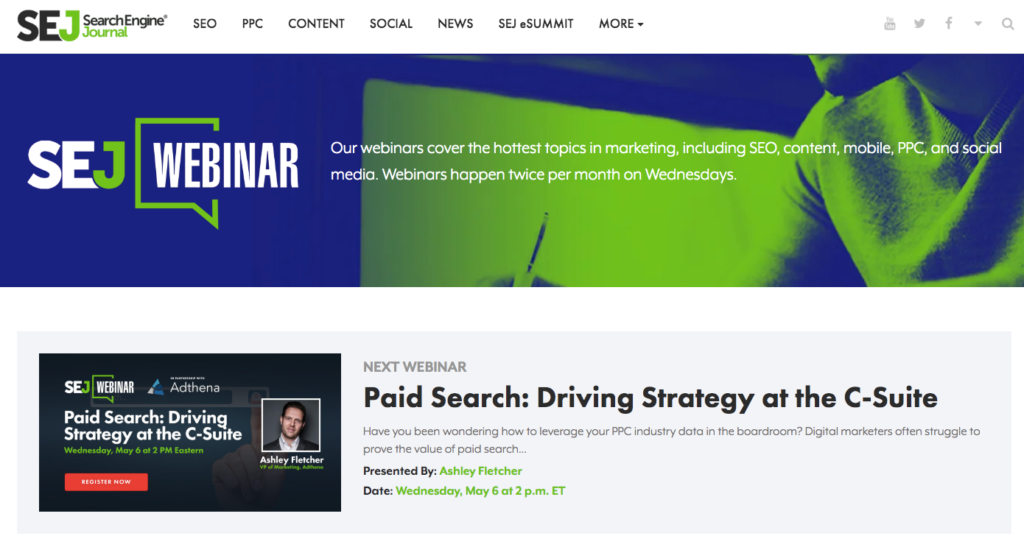
Start by searching for links of webinar series creators in your space.
You can use Google search using search phrases, like "webinar series" "INDUSTRY" or "webinars" "INDUSTRY".
Create a spreadsheet to fill in details of your target webinar creators. These include website name, the title of webinar series, host, and contact information. This helps you easily track the progress of your outreach once you begin with sending email pitches.
When doing outreach to webinar content creators, use your expertise, and describe how it can be of help to their audience. This is your value proposition — at its best. Maintain the conversation with your intent of providing more value to their followers than just appearing to be going only after for links.
Distribute webinars as guest posts
Another way to maximize webinars for link building is through the distribution of webinars as guest posts.
Essentially, you don't simply send links of your webinar videos to your target prospects. You check first with target guest blogs what they want as topics for their audience.
This is where you should play creatively. You can use the topic of the webinar as one of your suggested guest blogging ideas.
In addition, you may also chop a webinar into different topics (if the content is full-packed with information) and suggest these topics to your prospective publication.
You can check out this detailed guide on scaling guest posting ideas.
You can transcribe your webinars and turn them into actual guest posts (with edits on the side).
Another means is to only get insights and points of your webinars, use them as your outline, and write a guest post from scratch.
Both ways can help you craft a high-caliber guest post for your target blog.
Turn webinar slides into infographics
You want to maximize every piece of production for a webinar. That includes the slide presentation used for the discussion.

You can turn webinar slides into some kind of infographics, particularly if the points or information are easily digestible in an infographic format.
By outsourcing graphic works to a freelancer, you can automate this process of turning webinar slides into infographics. This makes more ROI positive if you are doing webinars regularly whether for internal or external production channels, as you get more infographics produced from many webinar slides.
Besides for link building purposes, webinars are also utilized to generate leads for a business.
Let's discuss how you can use webinars for lead generation.
How to Use Webinars For Lead Generation
As I've mentioned earlier, webinars have built-in value if it's presented by thought leaders in the industry. That makes it easy for content teams to get visitors to flow through the marketing funnel — potentially hitting the bottom line of new customers.
One high utility of webinars is making it as a bait for visitors to collect their email addresses in exchange for the video content.
Landing Pages
Create a dedicated landing page that emphasizes what your content consumers can get out of your webinars. Ensure you'll have forms to capture their email addresses. Example of which is this webinar landing page by Wordstream.
Short Videos
In the age of distractions, people tend to lose their attention quickly on long video messages. That being said, putting a webinar for them might require that your content is of high value in order to retain their attention.
The best way to capture more interests and make your brand gain more visibility is to chop webinars into short videos. These are videos that can stand on their own and can be disseminated quickly depending on how good your short video is.
What you want to do is to edit short videos in such a way that it highlights the value of information without losing much interest from its prospect watchers.
So, how do these short videos play in generating leads?
As you get more eyeballs to your micro content, you generate awareness of your brand, hitting two sections of the funnel — Attention, and Interest.
Podcasts
Podcast consumption has increased dramatically for years now. Taking advantage of this opportunity can help your business improve its lead generation activity by numbers.
Format webinars into audio content. Start a podcast featuring these new content pieces from your webinars. Repackage it such in a way that it keeps listeners engaged.
Key Takeaways
Don't just ride on the current trends in marketing where everyone is into webinars. Remember to have a good strategy and set of action plans to be able to maximize what you have produced in order to build more relevant links — and eventually, generate leads for your business.
Give consideration to how you distribute webinars to your target audience as this will help increase visibility and likelihood of your campaign success both for short term and long term goals.
Best Practices In Content Sharing To Increase Brand Awareness
Content sharing helps increase brand awareness of your website. When people share your content, you gain exposure for every web asset that's amplified.
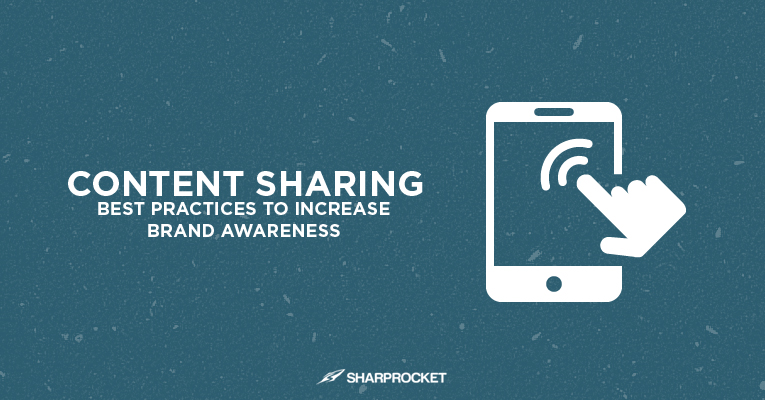
As part of a content promotion process of any brand, content sharing involves the use of social media platforms and other websites with significant engagement to circulate links of pages and content itself relevant to the audience.
One leverage to maximize content sharing on your content is to understand how people are being influenced, particularly persuaded to take any action that you desire.
Psychology of Persuasion Applied to Content Sharing
Influence matters to get people to share content. But how do you build or get one for your brand?
In the book "Influence: The Psychology of Influence" written by Robert B. Cialdini, he covers six universal principles to influence anyone better. These principles can help content marketers to make action plans on how they can get their target users to share their relevant content online.
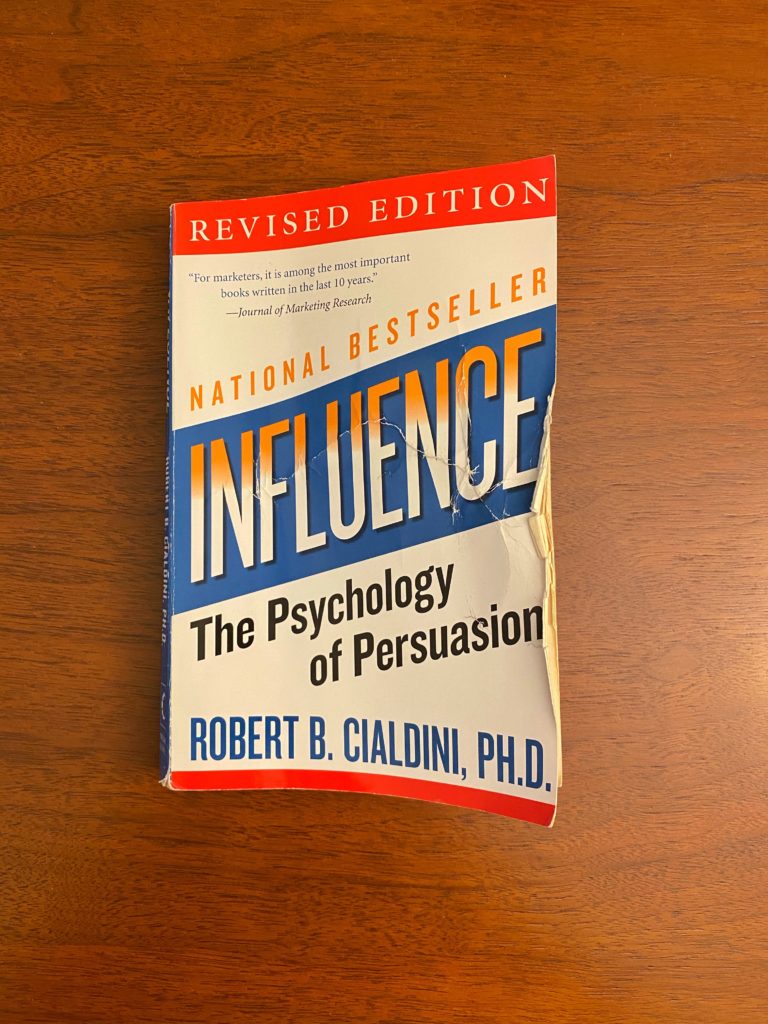
Let's start with the principle of reciprocity. It says, "If I do something for you, then you can or must do what I ask of you." By showing initiatives that bring value to your audience, your action can be reciprocated through a social share of your content piece.
The second principle that speaks of "I can't have it, I want it" — scarcity. If there are only a few people who get access to your content, it becomes more valuable than if it's available to consume by everyone.
"Liking" tells people, "If you like me then you are more likely to do what I ask of you." It speaks of pre-conditions that make you likable in the first place — which helps you get the attention you deserve. There is a higher likelihood when you ask people to look at your page and to share it with their social profiles when the brand or personality who asked of those desired actions is likable.
When you have built content authority, there is an immediate advantage to get the following - leading more eyeballs to your content. Social sharing is easier this time.
Another principle of influence is social proof - which refers to any people's recommendations to a certain thing. If a person you know shares a content piece and/or he or she recommends you to take a look at the article, you're likely to read it.
The last influence principle of persuasion plays a significant role in how your content can be shared online is commitment or consistency. A consistent brand voice, style, and messaging in content, for example, helps create brand recall to your web assets. This helps further better social sharing from followers and brand advocates.
So those are six principles that you can leverage for effective content sharing.
Now let's discuss some actionable tips that you can immediately implement right now.
Best Basic Practices in Content Sharing
1. Build your social media follower base.
Most content marketers would go out, connect with other like-minded people, and start sharing links of their pages. While that itself makes continuous content sharing possible, it is good to begin also building your social media base.
That means putting enough effort to add more followers to your social media profiles — these followers may include content creators whom you can absorb additional advocates from.
Here are some tips for building your social media base.
Create your social media profiles. Start with this activity first. Invest in appealing visual designs for your profile photos. This will help establish your social media brand. You can check out these articles for the basic setup of social media profiles — RavenTool's Social Media Setup Checklist and Improve Your Social Media Profiles In Less Than An Hour by HootSuite.
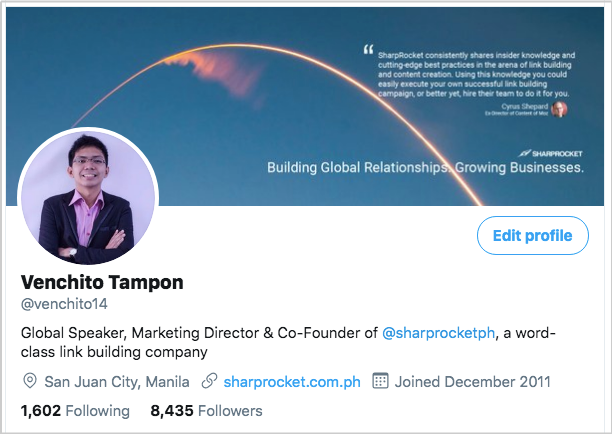
Start asking your existing offline followers/fan base, contacts, and networks of people to follow your personal/corporate social profiles.
By this time, you also need to understand your context of messaging. It begins by knowing your audience well — the channel or platform they mostly engage in, language or style they use, even their level or type as an audience.
Start sharing content pieces you produce on your blog, as well as other relevant articles that you find useful to your target customers. This gives a variety to your content sharing, besides just promoting your content.
2. Add social sharing capabilities to your content.
To continuously get social shares, your content must be shareable.
It's pretty basic, but I've seen articles that don't have any social sharing buttons to share links. And even if they have social shareability, the odds are it includes too many networks — which their audience doesn’t usually use for content sharing.
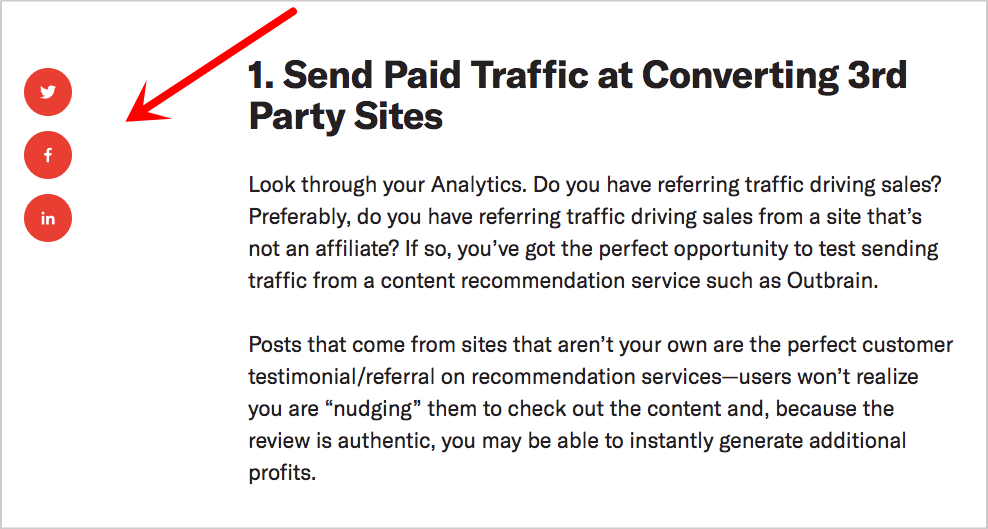
You may also add tweetability (I just made up this term) of your content by looking for quotes or statements impressive for sharing. You can install the Click to Tweet plugin and set up statements for Twitter sharing.
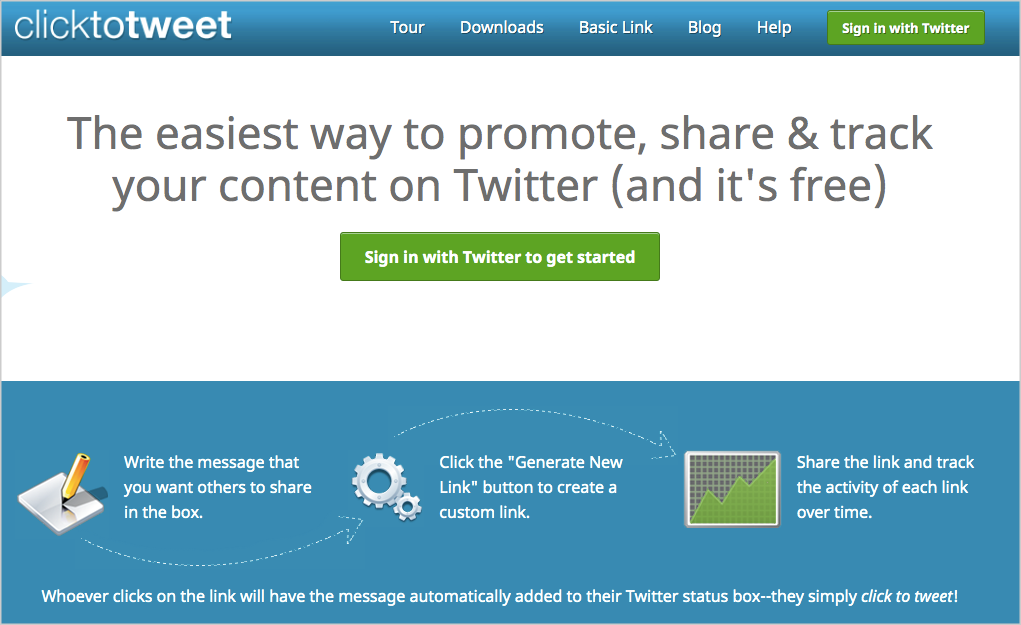
In addition, make sure you link to social profiles of names you mentioned in your post. That means, simply linking to their Twitter profiles if they have one. It's an excellent way to catch people monitoring mentions of their profile links and more likely even to share your content with their networks.
3. Get more citations from external content assets
As important as building your social follower base — investing resources to enlarge your following and promoting your content, you also want to look things externally.
For example, you can link to your relevant articles on your blog from your external content assets (e.g., guest posts). This will help increase the visibility of your content, as people could go through links and check your content.
4. Connect with influencers for content collaboration.
Influencer marketing is a buzzword these days. Every content marketer wants to engage in that initiative.
Take a look at the phrase's search trend, for example.

But how can one take advantage of influencer marketing?
In my guide on influencer outreach, I covered a lot more detail on how we can maximize the use of influencer marketing as part of content marketing campaigns.
It offers great opportunities for anyone - brand and independent personalities to get more following. In our subject, today, establishing a constant series of action plans for content sharing.
You can start by reaching out to influencers to get inputs on topics of their expertise. By having an interview series in mind, you'll be able to craft content that's meaningful to use for your audience.
I started my blog in 2013 by producing a series of interviews with digital marketing experts. I initially looked for local search marketing experts as I've had a few built relationships back then — making it easier to ask them to answer some of my questions.
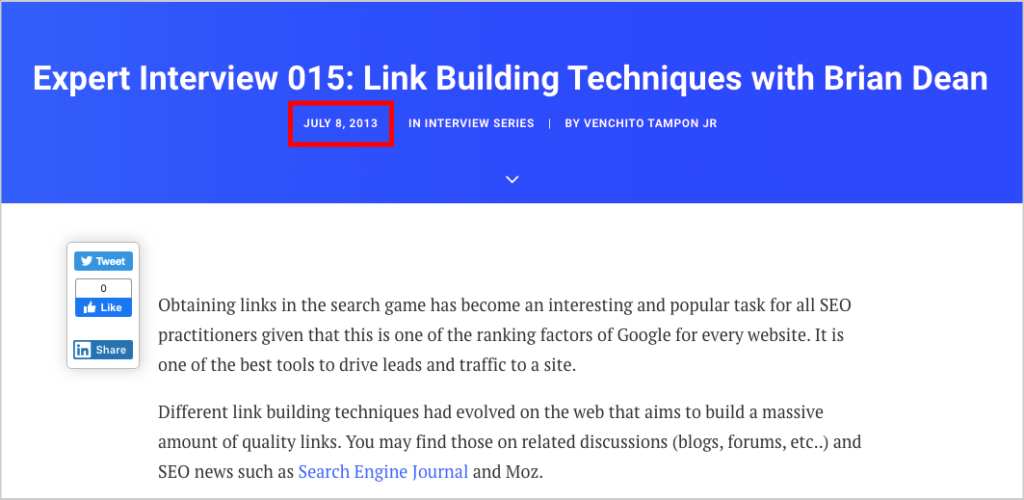
As you are growing your brand, you may also start collaborating with influencers for a piece of content. It's likely to give a boost in content sharing, as both social accounts are used to promote and amplify the content asset.
For further readings on influencer marketing, You can check out this guide on becoming an influencer by Jason Acidre, and this last year's presentation by Rand Fishkin on building influence (an evergreen resource).
5. Associate yourself with larger publications.
From a branding and SEO perspective, you can get more exposure through associating your site with more prominent names in your industry.
That is doable by becoming a regular contributor to larger publications in your space. Because they have a lot of traffic and are targeting the same audience as you're targeting, they can pass through additional followers that will help grow more of your social following base.
In essence, you're collecting and grabbing opportunities from people and entities your brand is partnering with.
Further Resources:
Content Sharing Made Simpler
With different platforms to engage your audience today, social sharing of your content becomes more feasible. Start looking for ways to establish your social media following based, grow it to enhance brand awareness, and deliver more value to your audience using your content.
How to Use Content Inventory For Effective Link Building
Content production may reach a limit where resources are maxed out. This is when you need to look at your current content inventory and see which content assets can be reformatted, reproduced, or repromoted.
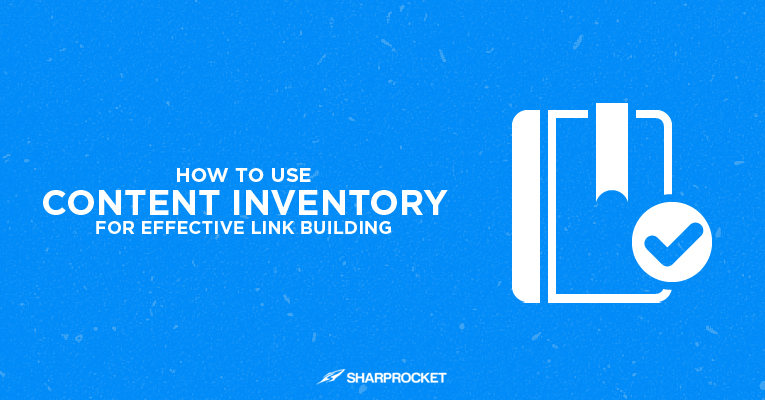
Whatever action you choose, your refreshed content will be of great use to gather more eyeballs in the form of social shares and backlinks.
What is a Content Inventory
Patrick Hathaway of URL Profiler defined content inventory as:
“A content inventory is a complete listing of every page on your website, with associated meta information and metrics, which allows you to make both general and specific evaluations of your website content.”
Essentially, content inventory gives you the exact data of which page to consider for repurposing.
You don't want to waste any resources you've exerted before for a given content asset. You take the time to see them again and use for current content marketing and link building campaign.
How to Use Content Inventory for Link Building
Here are some tips to get the most out of your resources when assessing the content inventory for link acquisition.
1. Identify content archives worthy of updates
Look for any pages that are either high-performing in terms of content engagements (links, shares, traffic, etc..) or under-performing — ones that may need some updates to be relevant for current topics.
You can use a variety of tools below to help you generate quick data of your webpages:
And here are some tutorial videos to get you started with those tools.
Once you have a list of pages at hand, take a look and see which are relevant content.
Generally, those are pages that would need more updating to match current events. For example, in today's Coronavirus situation, which pages would be resonating with your target people?
Are there are any evergreen topics about cleanliness, helping people in need, remote work, positivity, and parenting at home?
2. Dig into pages for BLB promotion
If you're active with producing linkable assets to build your brand authority, you're likely to have several content pieces in your content inventory.
Those linkable assets may include resource guides that have experienced one phase of promotion, either through simple linker outreach or broken link building type of activity.
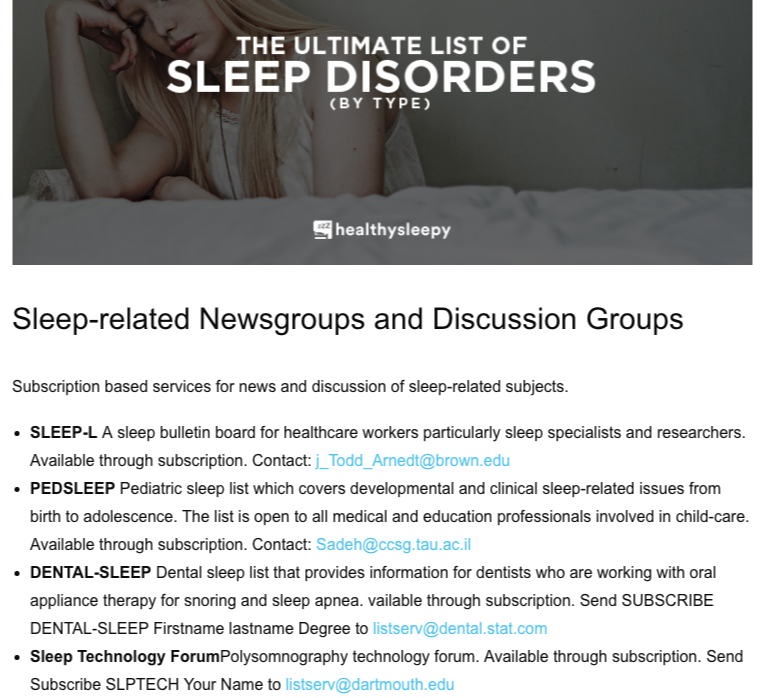
Can you promote a resource guide to new groups of linkers? Remember, there are new industry curators who have not been part of your first round of content promotion.
Start gathering new link prospects for your resource page. Add them to your existing list of linkers.
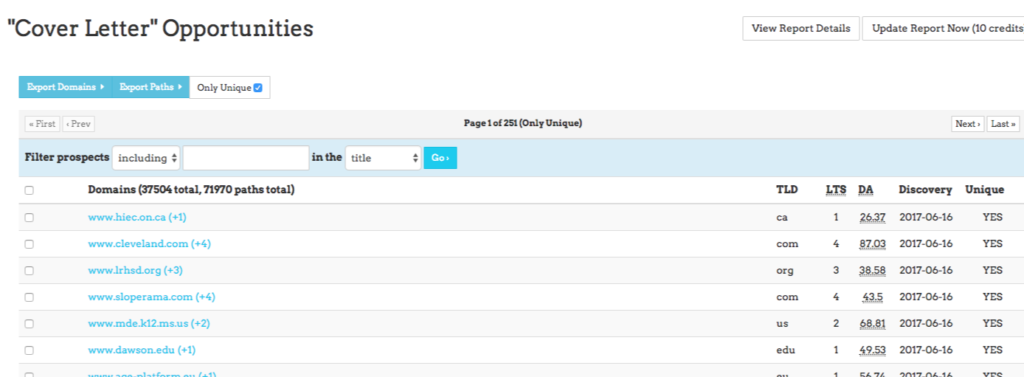
Then do the necessary steps to do some outreach.
Seek to do have a second round of outreach for your past linkers who didn't respond to your initial pitch—reconnecting after a few months to see if they're able to link to your resource content.
Sidenote: During this Coronavirus crisis, people are likely to respond to resource page requests given most (if not all) are working from home and have more time and means to edit webpages.
Another way to increase your link placements for a broken link building outreach is to think of angles that will resonate with your audience — tapping the current events.
For example, instead of sharing your parents' guide to getting kids to sleep better, why not consider an outreach angle that focuses on more activities like bedtime stories — helping parents to engage with their kids better.
By looking at your past resource guides that have garnered links, you'll be able to strategize ways to repromote them for other rounds of broken link outreach.
3. Generate ideas for future content pieces
Another advantage of taking a content inventory is you're able to spot topics that have resonated with your audience.
This means that your target audience has seen your content relevant to theirs and find it useful to what they are currently doing.
Essentially, you want to look for niche ideas that don't just capture their audience but have a lasting impact in solving their needs. The higher the contribution factor your linkable assets has to them, the more it generates value. Thus, it gives your content piece more chances of earning links.
Look at your past content pages. You can use Ahrefs to find highly linkable content assets. See from a link builder perspective which piece has generated a good number of organic links.
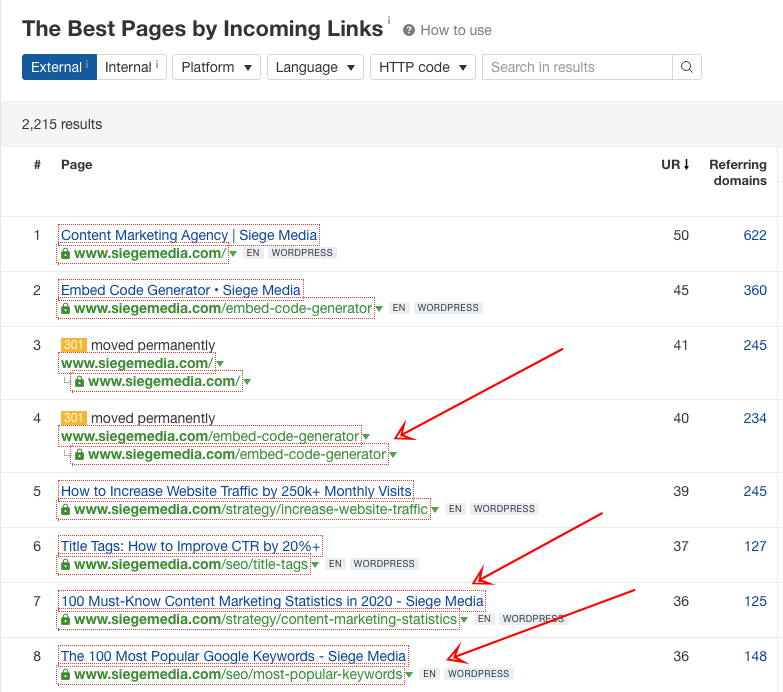
Are there any topics that keep on getting traction from time to time? Is there seasonality with the titles of your assets?
You may even search for those linked to your pages. And analyze how people link to your piece. Did they reference it to support their claims or information? Are those references can be repeated to other groups of linkers?
4. Build internal links from top linking pages
Internal links are as important as inbound links.
Identify pages that can earn links on their own. Start internally link to them from pages that need more link equity to boost their search visibility.
5. Match old content to current search strings
What separates a highly successful outreach campaign from a mediocre one is the ability to match content to search strings of people are using to find what they need.
Instead of searching for potential linkers with common search strings like "parenting tips" to find blogs whom you can reach out to for links. Use "parenting at home"-like key strings to match and serve the needs of people of today's current event where parents are at home.

Further Resources:
Put Old Assets to Good Use
Having a regular audit of your content inventory is essential to build momentum with your content marketing and link building campaigns. Take your resources to good use by repurposing assets and/or repromoting them to targeted audiences.
